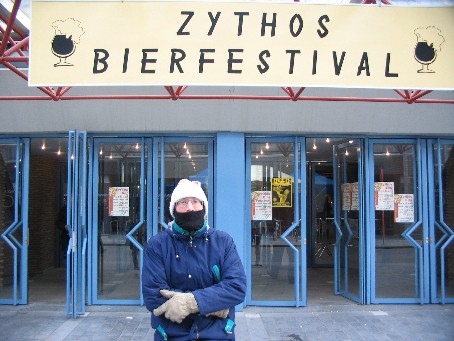 |
I’m baa-aaaack. [Cue Jaws theme music.] Just when my liver had regenerated, it was subjected once again to a bout of non-stop drinking that would have made Ted Kennedy proud.
A few notes about my beer reviews are in order.
Getting there was a bit unpleasant. My stomach was uneasy, travelling in a high-speed metallic object with the possibility of certain death looming over me. And that was just on the way to the airport.
It was a balmy 34° when I arrived at Baltimore-Washington International. I found my way to the Delta desk, which was right next to Hooters Air, which was next to Melons Air and Yabbos Air. After a refreshing stroll through airport security where I enjoyed the ecstatic pleasure of taking my shoes off and having someone stroke me with a wand in places that even my wife has never seen, I headed for the gate, which was at the other end of the airport. That’s always the way. This is how airlines save money on fuel – they make you walk halfway to your destination.
My 30-pound bag got heavier with each step. Everyone else had nice luggage with wheels and handles while I – a Neanderthal who has failed to evolve with the rest of humanity – trudged with my crude Bag of Burden, occasionally switching hands and being passed by senior citizens who gave me irritated looks for getting in their way.
Whew! Made it to the terminal (which is a poor choice of words for a location where people are about to put their lives in the hands of a guy who spent his last 45 minutes before the flight doing shots). The other people didn’t look like they were hauling a whole lot of stuff, but when I got on the plane, I found that everyone else had completely filled the overhead compartments with bags the size of Hyundais.
Two hours later I arrived in Atlanta. Now, as a rule I hate airports, but this one is quite nice, clean, and decorated with an eclectic mix of art. It also dwarfs BWI, but thankfully there is a “people mover” (subway train, but they don’t call it that) to take travelers from one concourse to another. I got to my departure gate with more than an hour to spare before hopping the pond, at which time I phoned my wife to let her know that I was all right (so far). She was concerned about my safety on the long flight to come, and I comforted her by telling her that my life insurance premiums were paid.
By the way, boarding on Delta is no longer by seat row; now it’s by “zone”. For example, rows 30-35 might be zone 6, while rows 36-41 might be zone 7. I’m so grateful for this system. I can’t count the number of flights I’ve missed because row number ranges confused me:
| Announcer: | “Now boarding rows 42 to 47.” |
| Me: | “Does that include row 33?” |
| Announcer: | “No, please step back.” |
| Me: | “Sorry.” |
| Announcer: | “Now boarding rows 36-41.” |
| Me: | “Is row 33 in there?” |
| Announcer: | “No, sir – please step back.” |
| Me: | “Sorry.” |
| Announcer: | “Now boarding rows 30-35.” |
| Me: | “Does that include me?” |
| Announcer: | “Let me see your ticket ... Sir, you’re at the wrong gate.” |
As usual I was unable to sleep on the 9½-hour flight. Gee, I wonder why: I was sitting upright in a seat that could easily accommodate a 5-year-old child; it’s not like I was uncomfortable or anything.
My friend Marty picked me up in Stuttgart on the morning of March 4. This was a beer-drinking trip, so naturally we went straight to a fossil museum, then to a gym to lift weights. Having thus used our minds and bodies for about an hour each, we had earned the right to spend the next two weeks drinking, so upon arriving at his house we had some of the beers that were left over from our previous trip. Hoegaarden Grand Cru (Hoegaarden; 8.5%) had a very nice estery, sweet aroma and flavor. Maredsous 10 (Moortgat; 10%) had a quite good, smooth, somewhat estery, alcoholic flavor. Then we had my homebrewed grand cru, which had a nice, interesting, coriander, estery flavor. Then I took a nap. Okay, I passed out, but let’s not split hairs over semantics.
That evening we met Marty’s wife Michelle and a bunch of their friends for bowling at a place called Dream Bowl. Since German establishments tend to serve only German beer, we drank an Orval (Abbey de Notre-Dame d’Orval; 6.2%) on the way. It was good and horsey. When we rented shoes, they didn’t keep our own shoes as collateral the way many American bowling alleys do. (It is very typical in Europe that they trust people.) Shoe sizes are different over there. I normally take an 11, but my bowling shoes were size 44. I think I’ll start buying condoms there.
We returned home afterward and had a Saison Dupont (Dupont; 6.5%). It was great as usual: earthy, estery, and a bit tart. We watched an episode of CSI on DVD. It was OK. Then I went to bed ASAP because I was PFT (pretty tired).
Saturday morning I awoke nice and relaxed after sleeping 8 or 9 hours, which is the most I had slept in months. I didn’t do much during the day except stock the fridge with beer for the dozen or so people who came over that afternoon to drink with us. You see, we had to make room for all the beer we would be bringing back the following weekend.
Arabier (De Dolle; 7.5%) was light and slightly estery. Westvleteren 6 (Abdij St-Sixtus ; 5.8%) was light, clean, and ever so slightly hoppy. We drank one of my homebrewed witbiers, which was good and estery and spicy. Oerbier (De Dolle; 7.5%) had a good malty, alcoholic, caramelly flavor and a good alcoholic, caramelly aroma. Cuvée du 4ème Anniversaire (Artisanale de Rulles; 5.2%) was light and clean. Rulles Blond (Artisanale de Rulles; 7%) was a fairly good, slightly estery beer with light body. Moinette Brune (Dupont; 8.5%) was a good caramelly, hoppy beer. It started snowing as we drank my homebrewed hefeweizen, and continued for a few hours. Next we had a bottle of Nuyts Blanche that we got from Abbaye des Rocs nine months earlier. At the time it was so new that they hadn’t even designed a label for it. It had a good fruity aroma and a good fruity, tart flavor; it got mixed reviews. Judas (Alken-Maes; 8.5%) had a nice estery, sweet aroma and flavor. Lindemans Framboise (Lindemans; 2.5%) and Lindemans Kriek (Lindemans; 3.5%) were both great and fruity as usual. Hercule Stout (Ellezelloise; 8.4%) had a pretty good somewhat roasty aroma and flavor. Hecht Schlenferla Rauchbier (Brauerei Heller Bamburg; 5.1%), from Germany, had a very smoky aroma and a moderately smoky flavor. My 8-year-old bottle of homebrewed spice ale got surprisingly good reviews. Uilen Spiegelbier (Van Steenberge; 8%) had a faintly tart aroma and a decent, somewhat tart flavor with strong carbonation. Maredsous Brune 8 (Moortgat; 8%) had a good fruity aroma and a pretty good fruity, alcoholic flavor. Tripel Karmeliet (Bosteels; 8%) had a nice spicy aroma and flavor with light body. We drank three of my homebrewed triples; one was over 4 years old and the others were less than a year and a half old. They all got very good reviews. Westmalle Tripel (Westmalle; 9.5%) was a nice estery, hoppy, fairly light-bodied beer. Bons Voeux (Dupont; 9.5%) had a nice earthy, estery, slightly tart aroma and flavor. Bière des Veschaux (Bouillon; 6.5%) was kind of like a pale ale: somewhat hoppy, not sweet, with good balance. Kasteel Brune (Van Honsebrouck; 11%) had a pretty good alcoholic, slightly roasty/plummy aroma and a good, very sweet, alcoholic, caramelly flavor. It tasted much sweeter than it smelled and could use some more hops for balance. Kaiser Doppel Malz (Kaiser; 4.7%), from Austria, had a slightly roasty aroma and a pretty good sweet flavor with fairly light body. I was feeling pretty good when I hit the hay at midnight.
Sunday the 6th. It was 22° with light snow on the ground. Marty and I headed for St. Niklaas, Belgium, where the Zythos Beer Festival (ZBF) was. We passed several towns with humorous names. Did you know that there’s a Frankenstein, Germany? After 8 hours of driving through sub-freezing weather and snow drifts we were 10 kilometers from St. Niklaas, and the bridge we wanted to cross over the Schelde River into town was out. We stopped at a nearby pub called the Sas Café and warmed ourselves with some tomato soup. I asked the teenage bartender for some ice (to cool the soup), and she said that it was too cold out for the ice machine to work. Now, correct me if I’m wrong, but if it’s below freezing out, can’t the machine simply do nothing, and the ice will form naturally? I’m glad I wasn’t ordering food in summer – she probably would have told me that it was too hot out for the grill to work.
We followed a dinky road along the river until we found a place to cross. As we approached town we stopped at a few places to find out how to get to the ZBF and our hotel (The Witte Huis). No one ever heard of either. Finally we got directions at a bar in town, and discovered that we had driven right past the festival and not seen it because there was nothing in front to catch people’s eye. Anyway, we checked into our hotel and walked in the Arctic wind to the festival. I don’t want to say it was cold, but the flashers were describing themselves.
 |
Inside, many hundreds of happy drinkers were enjoying about 150 kinds of beer from 50 breweries. Many were bottled and many were kegged. A group of young guys were dressed in hospital scrubs, as though it were Halloween. There were many Americans too. Several of the attendees were homebrewers, including two from BURP, which is one of my homebrew clubs. The beer samples were 15 cl (5 ozs) each, and Marty and I split them in order to maximize the number of beers we could taste before experiencing liver failure.
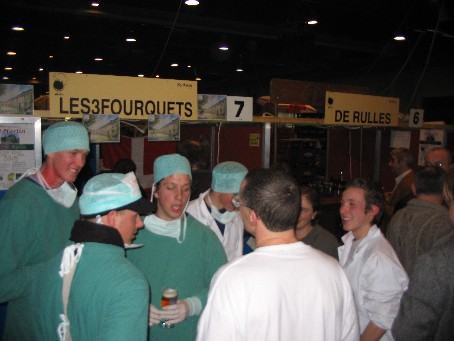 |
The first booth we hit was Artisanale de Rulles. We had met the brewer and his assistant twice before, and they gave us free samples of their latest beer, Cuvée Meilleurs Voeux (6.5%), which was dark and smooth. Then we moved on to many of the other booths. Paquerette (Les 3 Fourquets; 7%), an Easter beer with a Danish recipe, was light in flavor but slightly sweet and good. Guldenberg (De Ranke; 8.5%) was very smooth. XX Bitter (De Ranke; 8%) was very light in malt, and hoppy but not overly so. De Ryck Kriek (De Ryck; 4.9%) had a good moderately fruity aroma and a smooth, subtle flavor. Lamoral Tripel (Van Den Bossche; 8.5%) was fairly good but tame for a tripel to my palate; however, it was one of Marty’s favorite beers of the day. De Graal had three beers, and we tried them all. Gember (8%), made with ginger, had just enough ginger to give it a good flavor. Triverius (6.8%) had a fairly good slightly sweet/spicy aroma and flavor. Their Tripel was a nice malty, smooth beer. Loterbol Bruin (Duysters; 8%) was smooth, clean and good. Loterbol Blond (Duysters; 8%) had a good fruity aroma and a pretty good clean flavor. At this point Marty and I were already drunk, and the festival was hours from over. I got a small plate with two kinds of cheese, which they called “old” and “Nazareth”. Saison d’Erpe-Mere (De Glazen Toren; 6.5%) was a very nice saison – second only to Saison Dupont. It was crisp and flavorful and hoppy. There were a few tables where attendees were tasting and exchanging beers that they had brought with them. I tried one of them: Panil Enhanced (9.2%), from an Italian brewery. It was tart, somewhat sweet and pretty good. Hommelbier (Van Eecke; 7.5%), made with honey, was okay. De Koninck Tripel (De Koninck; 8%) had fairly light body and some sweetness but it was missing something. Kapitol Abt (Leroy; 10%) was clean and alcoholic. Urthel Samaranth Quadrium (De Leyerth; 11.5%) had a sweet, somewhat estery aroma and flavor. It was too sweet; it needed hops for balance. Tournée Beaurinoise (Caracole; 7%) had a nice slightly tart, estery flavor. Val-Dieu Winter (Val-Dieu; 10.5%) had very little aroma but a good sweet, malty flavor. Cuvée ’t Smisje 2005 (De Regenboog; 10%) was a pretty good sweet, malty beer but it was flat. Brussels Tripel (Domus; 8%) had a good somewhat estery/malty aroma and flavor. Zinnebir (Sint Pieters; 6%) was so-so. Angerik Amber (Angerik; 7%) had a good fruity, slightly tart flavor. Potteloereke (Sint Canarus; 8%) was okay. Lambiek (Drie Fonteinen; 4%) was tart and interesting. Chapeau Banana Lambic (De Troch; 3.5%) had a great, very banana-y aroma and flavor. Barbãr (Lefebvre; 8%), made with coriander and 2.5% honey, had a good spicy aroma and flavor. At this point I was so drunk that I bought a book that I did not realize was written in Dutch. The rest of the festival is a haze so I’m not sure of the beer information. De Troch Gueuze ? (De Troch; 5.5%?) had a quite good fruity aroma and flavor. Next was a Kriek (Lefebvre? De Troch?; 3.5%), which had a good tart aroma and flavor. Kameleon Tripel (Den Hopperd; ~8.5%) was pretty good. Alvinne Extra Bitter (Alvinne; 7.5%) was a fairly good hoppy beer. The Same Again (Bosteels; 6.1%) had a pretty good spicy aroma and flavor. Brice Tripel (Grain D’Orge; 7%) had a good spicy aroma and a pretty good spicy flavor. Chocolat (Fantôme; 8%) was fairly good. Troubadour Obscura (De Musketiers; 8.5%) had an okay, somewhat malty aroma and flavor.
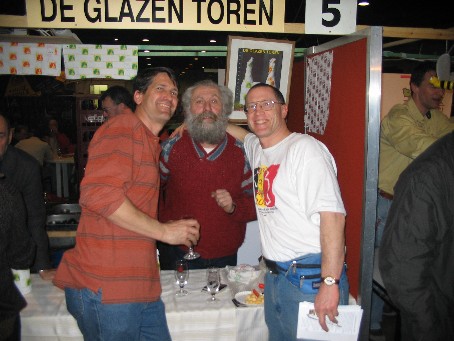 |
 |
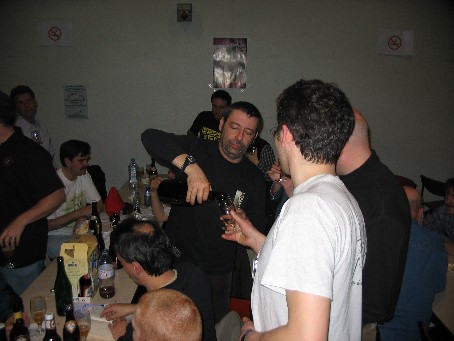 |
I have vague recollections of what happened after that. Somehow Marty and I managed to wobble our way back to the hotel room, I’m sure by his navigation, because it was almost a mile away and I was so crocked that I couldn’t find my ass with both hands.
Monday March 7. The Witte Huis (Dutch for White House) is a 100-year-old building, with distorted glass in the windows like we see in colonial houses. The dining room has old furniture and décor. We had breakfast and left.
We drove to Erpe-Mere in search of De Glazen Toren, whose saison we liked so much. We had no address because the place was too new to be on the Belgian Beer Routes map, so we stopped at a hamburger stand for directions and what Marty described as “the world’s worst hamburger”. The vendor had seen the owner on television the night before, but he didn’t know where the brewery was. However, there is a Glazentoren Street. Another guy, who seemed to be a friend of his, drove to Glazentoren Street in his car and we followed. Sure enough, we found the brewery. It was closed, and the sign in the window seemed to say that it was open Saturdays 10-noon and 2-4 p.m. I left a note with my E-mail address, and when I got back to the States I had a message from them. They officially opened on November 11, 2004.
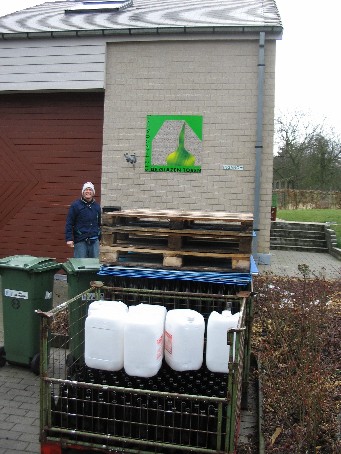 |
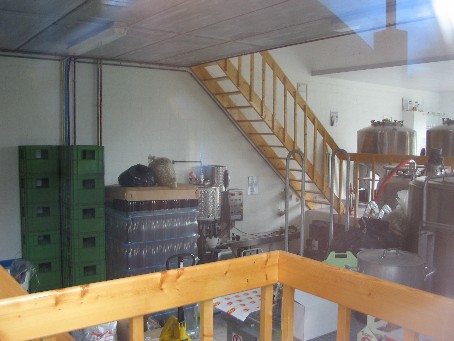 |
We drove to Buggenhout and arrived at the Bosteels brewery just before noon. Outside there were old stagecoaches with old flip-top bottles in them, and a classic pickup truck with a wooden bed. Normally brewery tours are by appointment only, but we got lucky – we wandered into the tasting room and there was already a group of Americans who had just gotten a tour. We had missed seeing the brewery but we were allowed to stay and taste beer and see a video about the brewery. The owners themselves, an older couple named Evo and Maries (sp?), served us. Tripel Karmeliet (8%), whose recipe goes back to the 1600s, had a nice sweet, estery aroma and flavor. It’s made with oats, wheat and barley. Kwak (8%), whose recipe is from the late 1700s, was quite malty and fairly good. Kwak is served in a “coachman’s glass”, which has a very thin middle and a big bulb on the bottom. Under the Napoleonic code, coachmen were not allowed to leave their coaches, so this glass was designed to hang on a special holder on the coach’s side. Deus (11.5%), pronounced DAY-us, is a beer made with the champagne method: it’s stored on its side, and every day the bottles are turned and uprighted just a little bit, until they are completely upside down and the yeast is in the necks. This process is called riddling. The necks are frozen, the bottles are turned right side up, and the tops are removed, taking the yeast with them in little cylindrical ice cubes. Deus is served when it’s 2 years old. Evo referred to it as a sparkling barleywine. It had a very light body for such a strong beer, like champagne, and a good, somewhat sweet aroma and flavor with no dry aftertaste.
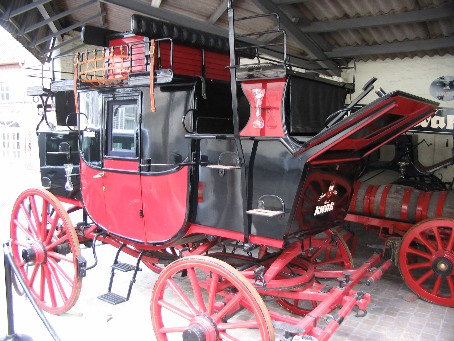 |
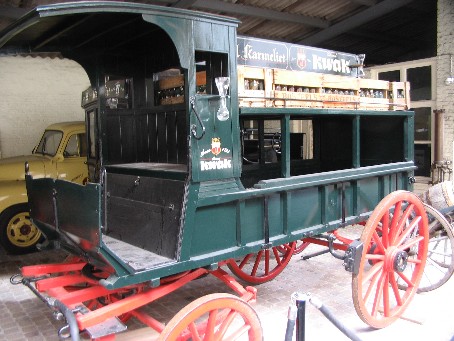 |
 |
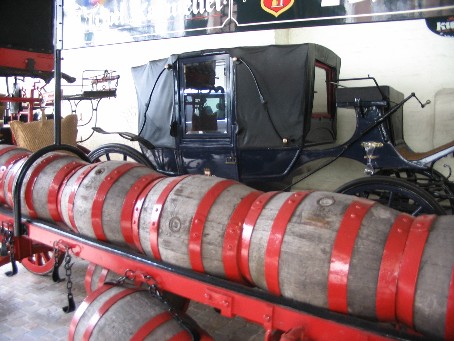 |
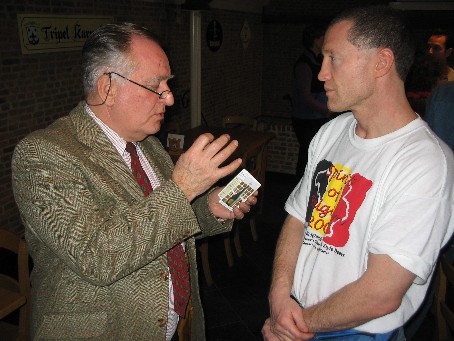 |
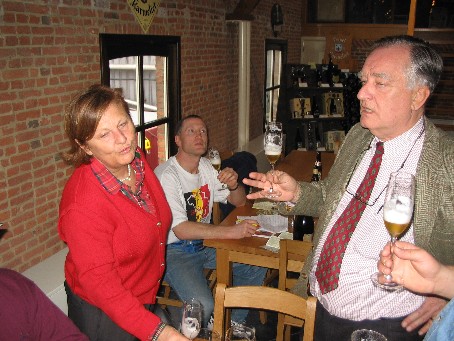 |
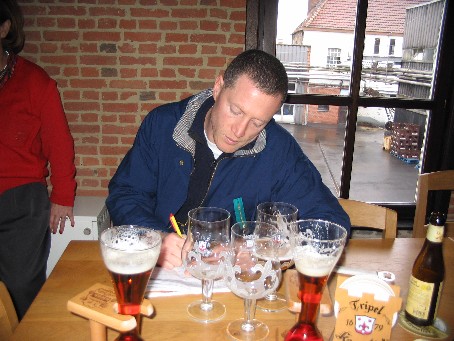 |
 |
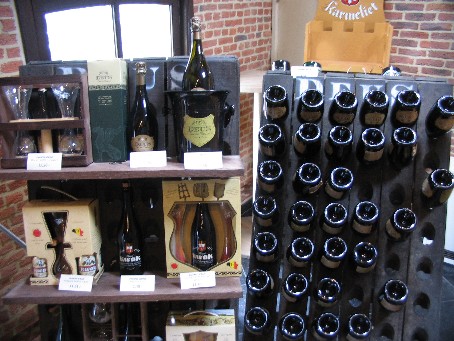 |
 |
We bought a lot of their beer and followed the tour group’s van to...
The brewery originally operated from about 1500 to 1944, after which it only bottled for several decades. Brewing operations started again in 1997 with new equipment. The tasting room is all wooden: the bar, the floor, the chairs and the tables. All the beers are filtered after fermentation, and fresh yeast is added for conditioning. Mr. Landtsheer said that other Belgian breweries, such as Van Steenberge and Westmalle, do this. He let us sample his beers, which were served from 20-liter kegs. Malheur 6 (6%) had a lager-like aroma and a fairly good slightly sweet flavor. Malheur 10 (10%) had a nice malty, estery aroma and a nice somewhat estery/sweet/hoppy flavor. Malheur 12 (12%), a dark, 1-year-old beer with a secret mixture of herbs, had a fairly good plummy/sweet/malty aroma and flavor. There is also a Malheur 8 (8%), which is only for bottled export; the reason has to do with the fact that taxes triple on beers above 8%. They also make a champagne beer called Malheur Bière Brut (11%), which is made in a similar fashion to the Bosteels Deus. It starts out as Malheur 10, but after filtering, it is given a champagne yeast and a little more priming sugar than the other beers receive. Champagne yeast is used because it’s less sticky and slides down the bottle better than beer yeast does during riddling. This beer had a nice somewhat fruity/estery aroma and a quite good somewhat sweet/estery/alcoholic/fruity flavor. There is also a dark version of this beer but it was sold out. Mr. Landtsheer claims that the attenuation he gets is 91% for his regular beers and 94% for the champagne beers. (For those who aren’t beer geeks, attenuation is the percent of wort sugars that get fermented. Most yeasts get about 75% attenuation.) All the beers are made with 100% barley malt.
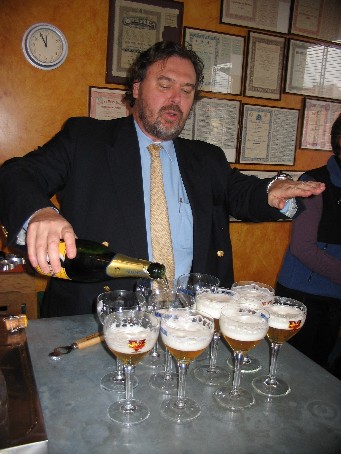 |
 |
 |
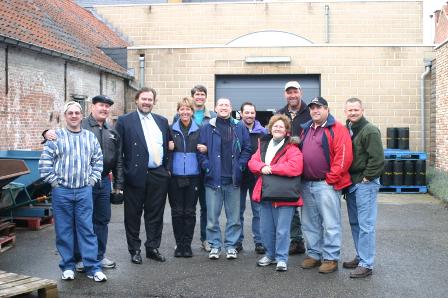 |
We got to tour the brewery. There are three 6800-liter lagering tanks. (All their beers are ales. “Lagering” in this context means that the fermented wort is held at a low temperature in order to accelerate the precipitation of wort solids.) All brewing is controlled by a panel of buttons. They brew every week, use steam heat, add candi sugar to the boiling wort for color, and aerate with pure oxygen. The wort is 17-18°C (63-64°F) at pitching time. Primary fermentation lasts 6-12 days. Bottling is done at the Affligem brewery 5 miles away; the fermented wort is trucked there in a movable tank. Affligem also bottles for Moortgat and Palm.
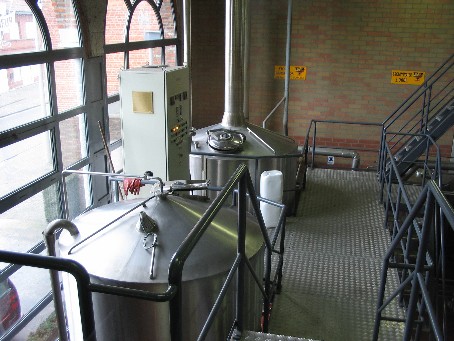 |
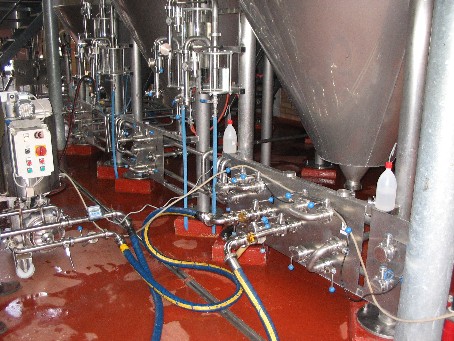 |
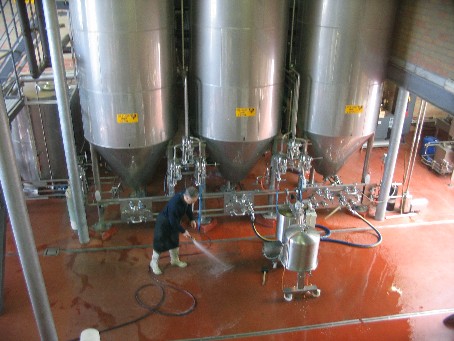 |
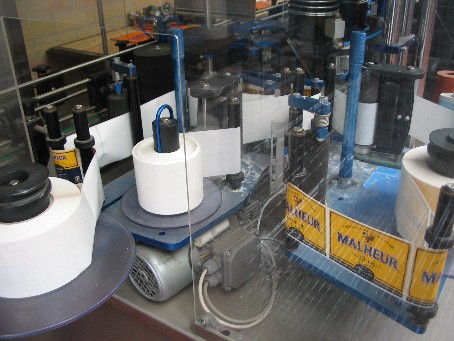 |
 |
 |
We bought a case of Malheur 10, and a case of another beer called Souvenirs du Terroir Tripel. We had tasted the latter beer the previous year, and I liked it very much, and I was surprised that Mr. Landtsheer did not mention it. I had to specifically ask for it. Apparently it’s made only for a certain portion of the country, I’m not sure.
Next we followed the tour group’s van to...
This brewery makes many different beers. Some are its regular line, and others are contract brewed. Yearly output is 50,000 hectoliters (1.3 million gallons, or more than 400,000 barrels). The brewery was built in 1791. The owner is 6th generation. The brewing equipment is fairly new. Their ales are fermented at 18-20°C (64-68°F), lagers at 6-8°C (43-46°F). They will brew 3 batches of a particular beer, then mix them in order to get a more consistent product. They lager at 2°C (36°F). All their beers except Celis White are filtered. The Bornem Tripel and the pilsner contain 8% rice in order to achieve lighter color (and I thought only megabrewers did this).
We got to see the 100-year-old equipment that was used until 1993. The only reason they stopped using it was that they needed more capacity. Then we saw the new equipment. They have a large bottling line that does 23,000 bottles an hour. That’s more than 6 bottles a second! A machine inspects the bottles and rejects any that are the wrong size, contain foreign objects, etc. They contract bottle for other breweries.
 |
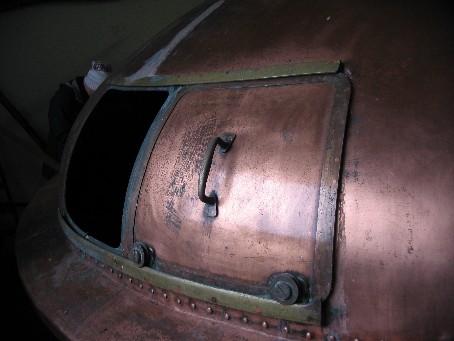 |
 |
 |
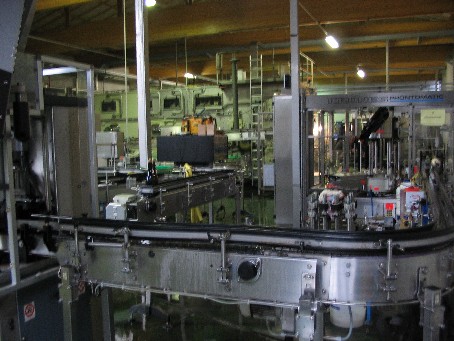 |
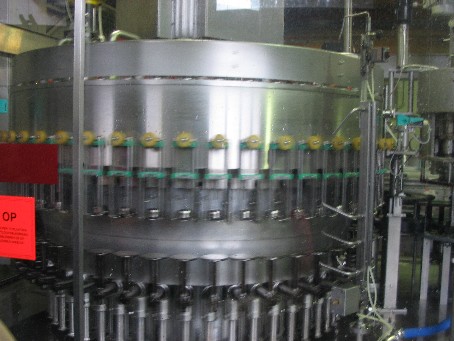 |
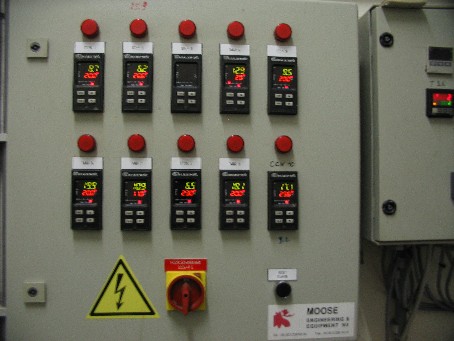 |
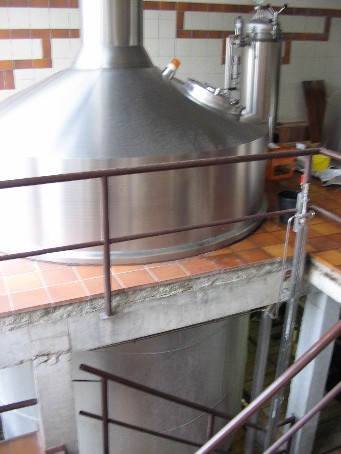 |
Their tasting room has a very nice bar, stucco walls, and an old brick ceiling. A man named André Van de Velde (I’m not sure whether he’s the owner) let us sample a few of his wares. Augustijn (8%), an abbey beer, had a fairly good slightly estery, sweet aroma and flavor. It tasted like an estery beer mixed with a lager. Piraat (10.5%) had a nice sweet, somewhat estery aroma and flavor.
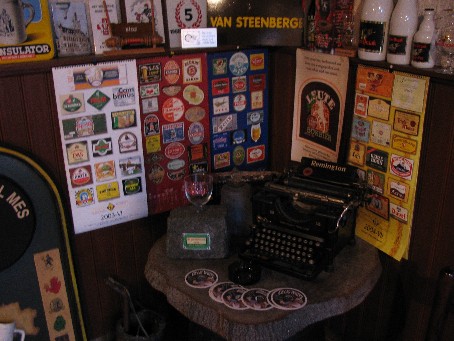 |
 |
We bought some beer, thanked the tour guide for letting us tag along, said good-bye and drove down to a town called Beersel.
This lambic brewpub had smoking and nonsmoking sections. I’m hoping this means that Europe is moving toward smoke-free establishments. (I heard that Ireland had recently banned smoking in bars.) The décor was nothing special, but we were there for the beer. Beersel Bio (7%) had a pretty good slightly sweet and smooth aroma and flavor. Lambik 3 Fonteinen, on draught, had a good fruity, somewhat tart aroma and a good, quite tart, musty flavor, like a gueuze. Unfortunately it was mostly flat. Oude Geuze 3 Fonteinen, also on draught, had a very nice tart aroma and flavor. Oude Kriek 3 Fonteinen (5%) had a deep burgundy color; a good malty, fruity aroma; and a good musty, fruity flavor with a tart aftertaste. We wanted to buy some beer to take with us but their store is open only Thursday-Saturday 9 a.m. to 7 p.m.
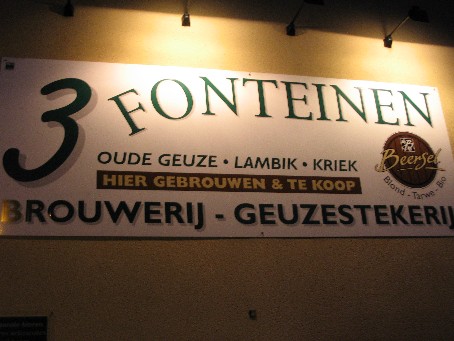 |
We checked into the Centrum Hotel and walked down the street to the Oude Pruim. It opened in 1871. It has a brick bar with a black top, brick walls and high ceilings. The brick looks new. It’s open from 9 a.m. to 10 p.m. for food, and remains open for drinks until the last person leaves. Closed Wednesdays and Thursdays, as well as holidays and two weeks around Christmas/New Year. Our server, Antoine Derauw, is the 5th generation owner. There were more than 50 beers on the menu. Deugnies Tripel (Du Bocq; 7.3%) was tame for a tripel. Villers Tripel (Huyghe; 8.5%) had a fairly good fruity aroma and a good fruity flavor. Antoine told us of a beer store not too far away called BVS, and he even printed us a map from his computer.
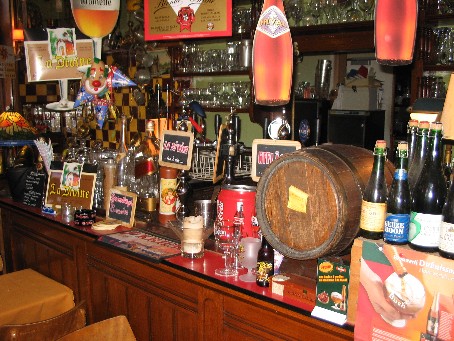 |
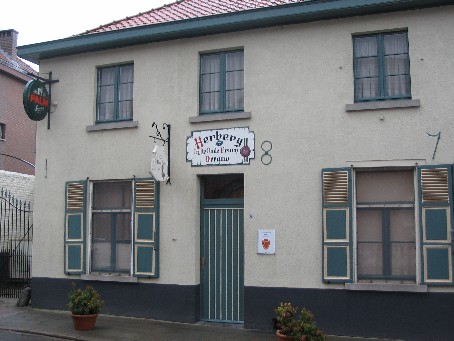 |
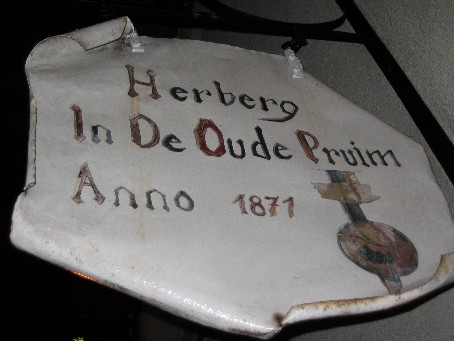 |
Note: Across the street there is a bar called Nieuw Pruim, which Antoine’s grandfather’s sister started around 1900.
Tuesday the 8th. I paid $109 to fill the tank. The high price was due to the combination of gas costing $5 a gallon and the fact that the value of the U.S. dollar against the euro is going down faster than a crack whore on Marion Barry. We drove to Sint-Pieters-Leeuw in search of BVS. As usual we got lost and stopped for directions a few times. This always makes our travels an interesting challenge. Eventually we found it. It was beer heaven: hundreds of kinds of Belgian beer. They had many lambics and gueuzes, including the Oude Geuze 3 Fonteinen that I had enjoyed so much the night before. There is a small bar inside that apparently serves as a break room. We spent close to $500 on about 11 cases of beer, although we later discovered that they had accidentally overcharged us by about $70.
 |
 |
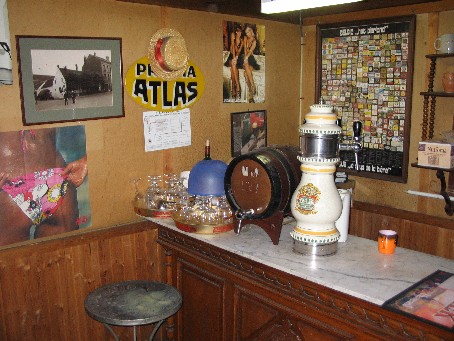 |
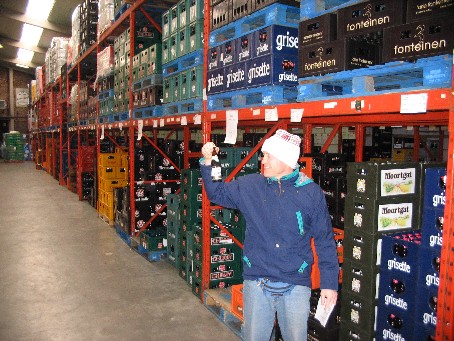 |
Onward to Kobbegem to find Mort Subite (used to be called De Keersmaeker) and a pub called Wit Paard. The highway signs said we had to head toward a town called Asse, which was very appropriate since Marty and I are always after asse. Anyway, Murphy’s Law prevailed: Mort Subite does not give tours, and the sign in Wit Paard’s window said that it’s open every day except Tuesday.
 |
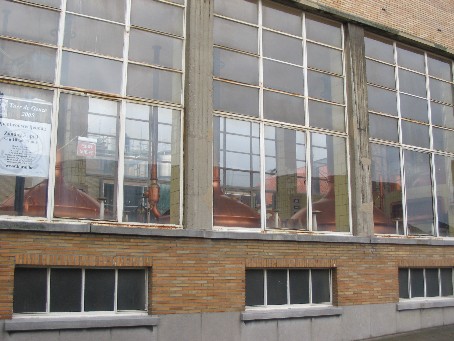 |
Undaunted, we drove to Breendonk where the Moorgat brewery (maker of Duvel) is located. We ate at a pricey, upscale place called Schutterschof. Hoegaarden Grand Cru (Hoegaarden; 8.5%) had a nice estery aroma and a nice estery, slightly tart flavor.
Moortgat is a large brewery. Not as big as Coors or Anheuser-Busch of course, but much bigger than the small artisanal breweries we are used to visiting. Tours are by reservation only, and they last 3 hours. They include a movie and a tasting, and cost €4 per person. Most tours are given in Dutch.
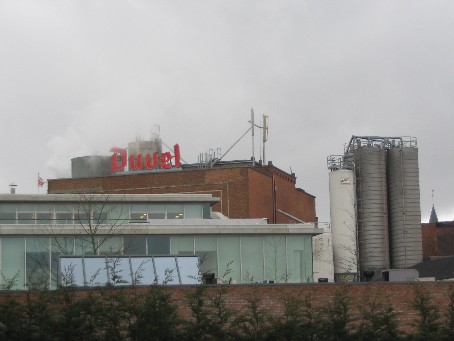 |
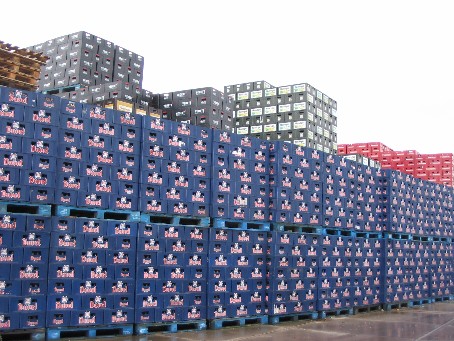 |
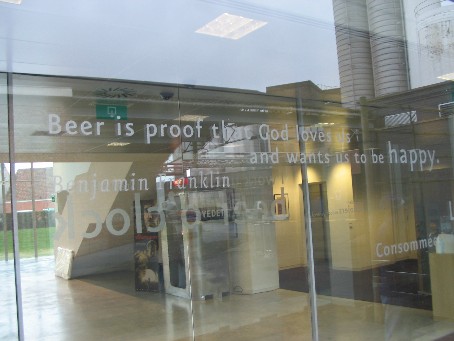 |
 |
We went back to the car. Marty opened a Hercule Stout (Ellezelloise; 8.4%), which erupted all over him. Good thing he hadn’t pulled out yet. We headed for Brouwerij der Trappisten van Westmalle, stopping in Schilde along the way to buy chocolate.
Brouwerij der Trappisten van Westmalle is one of the six Trappist breweries, and it’s located at a monastery. We approached a side door where another visitor rang the bell. Monks came to the door. I went in and bought a hunk of cheese, which the monks make there. It was very good. They do not give brewery tours, which we knew ahead of time. What we didn’t know was that we could not even buy beer there.
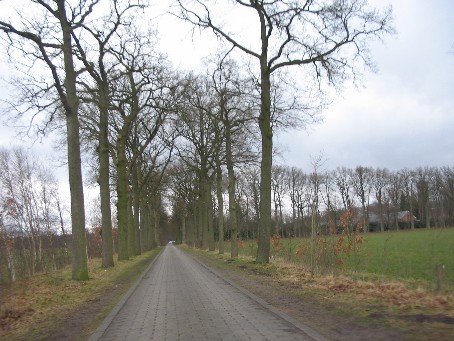 |
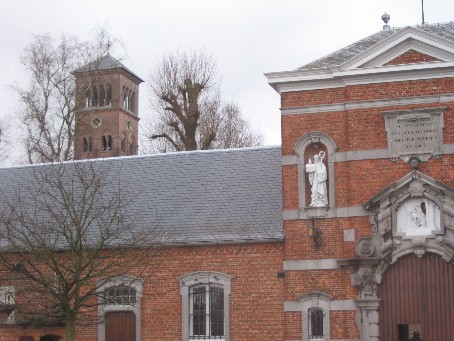 |
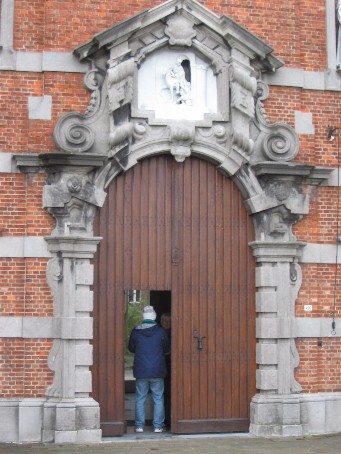 |
Across the street is the Café Trappisten. The ceiling has open wooden beams and there is a lot of wood in the interior. They serve beers from several breweries including Westmalle. We each ordered a Westmalle Tripel (9.5%), which was nice and estery and somewhat sweet. We also got bread and some Westmalle cheese. It came with hot mustard which was good too. We were the youngest people in there. Some folks were easily 80 or 90. I thought that perhaps a convalescent home was having a field trip.
We hit the road again, navigating Dutch signs with completely indecipherable words. What’s with that language? You could throw every letter in the air, string them together in whatever order they landed, and end up with something more pronounceable than the language itself.
No, Mechelen does not make tires. It’s a town about halfway between Brussels and Antwerp. We checked into the Hotel Carolus. The Het Anker brewery is right next to it but doesn’t give tours. There is a cozy restaurant/bar right there that serves the Het Anker beers, so we had dinner there. The bar had a big anchor in it (anker is Dutch for anchor). Gouden Carolus Tripel (9%), on draught, had very little aroma and a little bit of sweetness. Gouden Carolus Classic (8.5%), also on draught, had a slight caramelly aroma and some caramelly flavor. It wasn’t bad. All the Het Anker beers are on tap; the only size bottle they have is 750-ml. They have a full menu and the food was great. The kitchen is open Monday, Tuesday, Thursday, Friday and Saturday noon – 3 p.m. and 6-10:30 p.m.; and Sunday noon to 10:30 p.m.
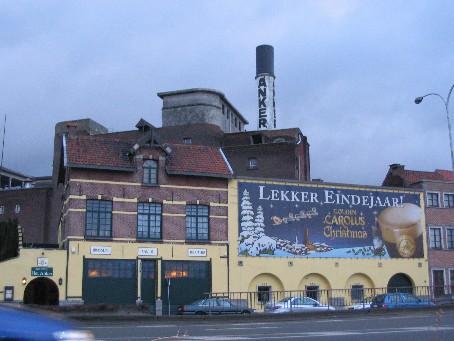 |
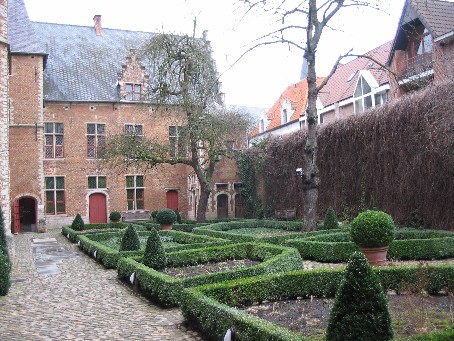 |
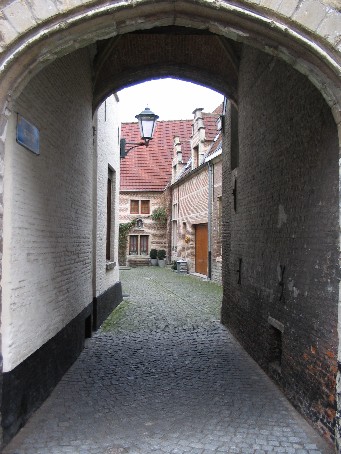 |
After dinner we walked to a bar called the Stillen Genieter. It was closed. It had a sign on the door written in Dutch with an arrow pointing to the right. We thought that it was saying to go in through another entrance, but we couldn’t find one. We went next door to Café De Gouden Vis, which was a pretty place with an even prettier bartendress. Hapkin (Alken-Maes; 8.5%) had a good slightly sweet aroma and a good, refreshing, semi-sweet flavor. I went back to the Stillen Genieter, which was still closed, and got a passer-by to translate the sign. It said, “If no one is here, ring the bell next door.” So I did, and a portly gentleman came down and opened the bar. It opens every night at 8 p.m. but the owner doesn’t open it until he has to.
I retrieved Marty and we entered. It was a nice dark, cozy place with lots of posters on the walls and a brick bar with a wooden top. Behind the bar were stairs to a cellar where the beer is kept. Classical music played in the background. We had the place to ourselves for about a half hour before someone else came in and fouled the air with smoke. The place has been open since the mid 1980s. The beer menus are basically books because they list about 300 beers. The beers are arranged by genre: abbey, Trappist, fruit, seasonal, non-Belgian, and nonalcoholic. I did not recognize many of the brewery names, probably because they don’t exist anymore.
Oude Geuze Vieille (Oud Beersel; 6%) had a nice tart aroma and flavor. The bottle said the expiration date was the year 2020. That’s good, since Oud Beersel had recently closed. Ne Kasselstamper (De Block; 8%) had a good sweet, fruity/tart aroma and a pretty good slightly sweet flavor. We moved to a table and played chess the rest of the evening as we drank. Dikkenek (Dikkenek; 5.1%) had an okay, somewhat caramelly aroma and flavor. Its color was reddish amber. Sezoens Blond (Martens; 6%) had no flavor or aroma. Antiek (Vieille Villers; 8%) had a decent sweet aroma but a watery, sweet, raisiny, unpleasant flavor. Cezarken (Crombe; 5%) had a good slightly tart aroma and a pretty good tart flavor. Noël Christmas Weihnacht (menu said Verhaeghe but bottle said Brouwerij Vera Vichte; 7.2%) had a good sweet aroma but a too sweet, cloying flavor. Abbaye de Warneton (menu said Brasserie de la Poste but bottle said De Bruyne) had a good tart aroma and flavor. It was in an etched bottle. Abbaye de Dieleghem (Lefebvre; 7.5%) had a quite good fruity, caramelly aroma and a fairly good somewhat tart, slightly caramelly flavor. Gentse Tripel (Van Steenberge) had a fairly good sweet aroma and semi-sweet flavor. Drossard (Duysters; 7%) had a decent, somewhat caramelly aroma but a not-so-good, somewhat caramelly flavor. Ne Janneman (Piron; 8.5%) had a nice sweet, fruity aroma, but its fruity/sweet/estery flavor was stale. Eventually the dozen beers took their toll on the two of us: we were dozing off in the middle of our game, so we left and hit the hay around 1-ish.
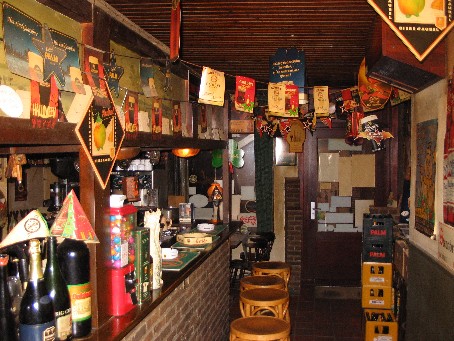 |
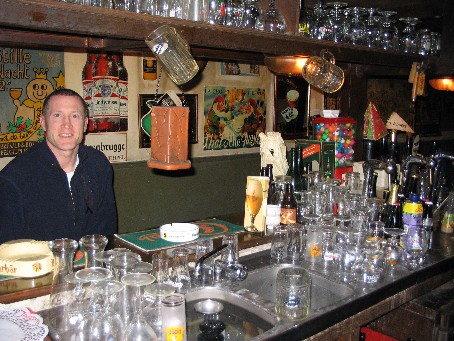 |
 |
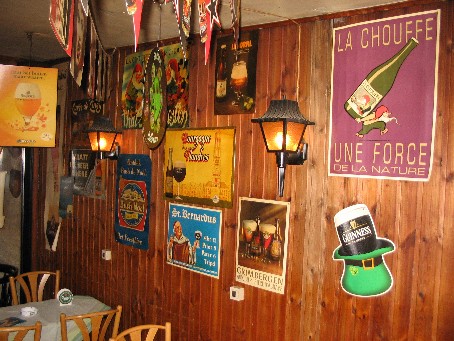 |
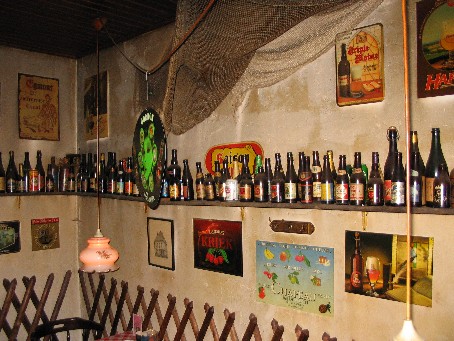 |
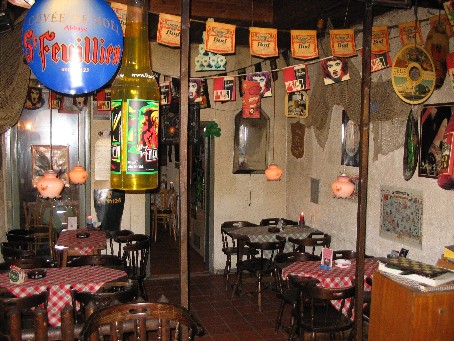 |
Wednesday March 9. We walked the cobblestone streets to a busy part of Mechelen to see it in the light of day. Many of the buildings have facades on top, but they’re mostly different from each other, unlike in Brugge where they’re all the same.
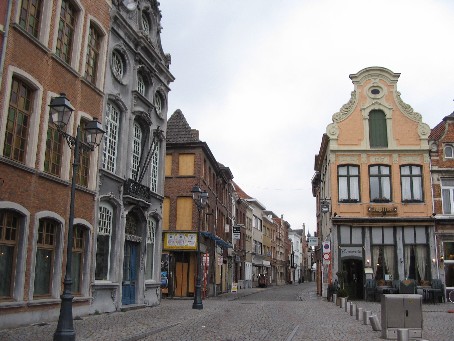 |
We went inside St. Rombout’s Cathedral. It looked very much like St. Michael’s in Brussels, with very high vaulted ceilings and beautiful, detailed stained glass windows. One window, from 1860, looked 3-D. I hit a few chocolate stores and then we drove to Kobbegem.
 |
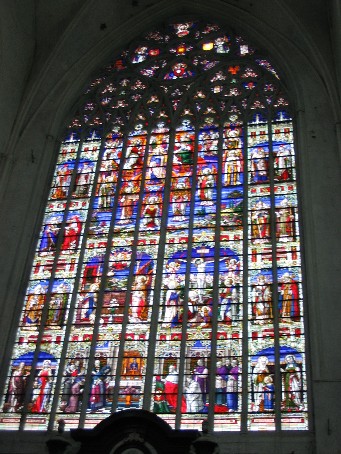 |
The Wit Paard (Dutch for White Horse) has been in business since 1749. It had a fire at one point and was restored. It’s open every day except Tuesday, from 10:30 a.m. until the last person leaves. It has a beautiful round wooden bar. There were 3 beers on tap and 15 in bottles. Food was limited to tomato soup, so we had some with our beer. Grimbergen Blond (Alken-Maes; 6.7%) was a decent beer with a slightly malty/estery aroma and flavor.
 |
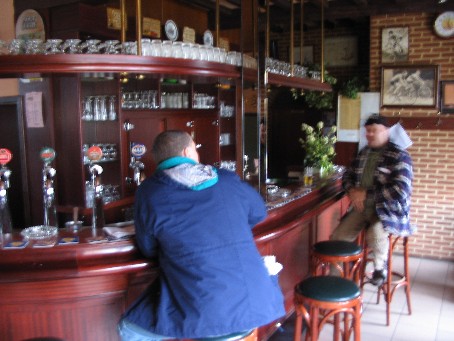 |
We learned a few things from the bartendress and a patron. Mort Subite, which is right next door, bottles only one of its own beers (the Oude Geuze); all others are bottled at an Alken-Maes plant in Alken. Alken-Maes owns Mort Subite, and this is just part of a nationwide trend of big breweries buying up smaller ones. When this happens, brewing gets consolidated into fewer places, resulting in a loss of jobs. I hope that beer quality does not decrease, but I fear that it will as efficiency replaces artisanship. In other news, Dubuisson lost a court battle with Anheuser-Busch over the name of one of Dubuisson’s beers, called Bush. This brings up three points: 1) How can a giant like Anheuser-Busch, who sells cold fizzy urine to tasteless people all over the world, feel threatened by a Belgian brewery’s 12% ABV product that resembles what Anheuser-Busch makes about as much as Britney Spears resembles Roseanne Arnold? 2) Anyone with a first grade education can see that Busch and Bush are spelled differently. 3) Did I mention that Anheuser-Busch products suck? It’s worth repeating.
We crossed the invisible line that separates the Flemish north (Flanders) from the French south (Wallonia) and went to Brasserie Dupont. We had been there twice before, but we had to go again, not only because they make great beer, but also because I had recently found out that they make bread and cheese as well. How interesting that they never tried to sell us any. The bread, which is cooked on a wood fire, is sold only Thursday afternoon to Saturday morning, and today was Wednesday, but they sell cheese all the time, and we were allowed to taste it. They make three kinds, all with the word “Moinette” in the name, which is also in some of their beer names. The “young” cheese, called Moinette, was nice and smooth. The “old” cheese, called Moinette Vieux, was also nice and smooth, and not being a cheese connoisseur I can’t find words to describe the taste difference. Moinette au Malt et au Houblon, made with malt and hops, was more flavorful than the others and had a slight twang. We each bought some of this one. And of course we bought lots of beer.
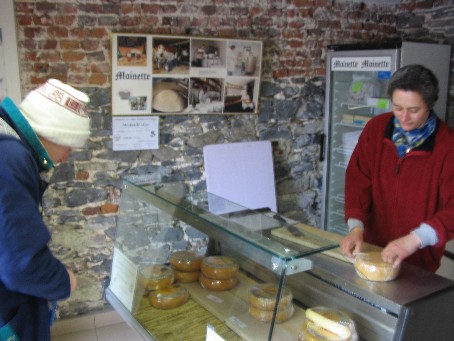 |
We went to Caulier Freres, where we had also been twice before, in nearby Péruwelz. As usual, the pub was closed but the door was open so we were able to walk around inside. We then went underneath to the drive-thru beer store and bought some beer. We learned that the pub has been closed for good because they just weren’t getting much business. Too bad, because it’s a big, beautiful place, with a very nice round wooden bar, a copper tap tower, an indoor waterfall and a goldfish pond.
There’s a bar in downtown Péruwelz called La Ménestrel. It has lots of posters and pictures on the walls, and it appears that musicians play there at night. The bathroom was horribly scummy, and there was no soap or towels. After rinsing my hands with water I asked the bartender for a towel; he handed me a dirty bar rag. He did give me a bunch of coasters though. The menu had upwards of 70 beers, but the bar didn’t have them all. Like many other bars, the beer menu listed only the beer types, not the brewery names. For example, a menu might list a “Triple”. Well, there’s a big difference between, say, a Westmalle and a Deugnies, so one would be wise to ask which Triple they have before ordering one. Triple Toison D’Or (John Martin’s; 7%) was not to my liking. Kasteel Blond (Van Honsebrouck; 11%) had a nice sweet, estery aroma and flavor. There was some alcohol in the flavor but it did not taste like 11%. Bourgogne des Flandres (the back label was missing but the front label said, in tiny letters, Van Houtiyvek) was a yeastless beer with a fairly good malty/caramelly aroma and a decent caramelly flavor but not enough esters or hops.
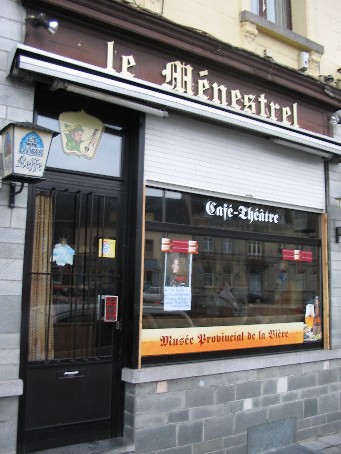 |
 |
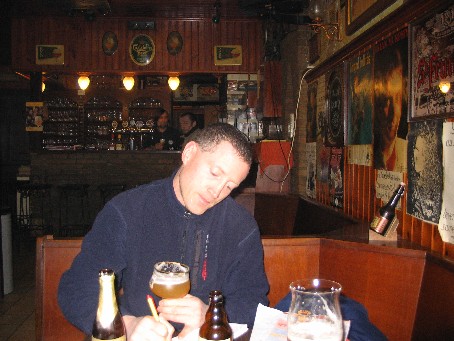 |
On a whim we went to Pipaix, where Brasserie A Vapeur is located. I had met brewer Jean-Louis Dits and his wife Vinciane Corbisier two months earlier at a Belgian beer conference in Arlington VA called Spirit of Belgium. The tiny town seemed empty. We parked in front of a bar (which was closed) and walked down the road to the brewery. Someone was coming the other way in a forklift, and sure enough it was Jean-Louis. We greeted him, and he radioed Vinciane to let us into the brewery while he finished his work. The brewery was built in 1785. In 1895 it was converted to steam power, and they still use the mash tun that was made that year. The large belts and sprockets were reminiscent of those you might find in a large clock tower. This is the only completely steam-powered brewery in Belgium, and possibly the world, which is how it got its name (vapeur is French for steam). They have two steam boilers so that there is always a backup. They brew 1000 gallons at a time, and it goes into their 4000-liter fermenter. None of their beers are filtered. They also have a distillery where they distill their own beer into spirits.
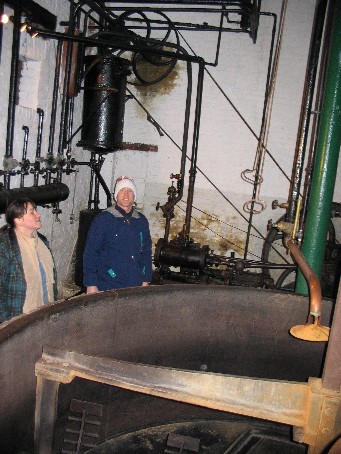 |
The large tasting room is very old and rustic, with brick and concrete walls, a brick ceiling, and a wood stove. Jean-Louis generously shared his beers with us. We offered to share some of our stash, but he politely declined, reminding us that he can get just about any Belgian beer anytime. Saison de Pipaix (6%) had a pretty good somewhat tart aroma and a pretty good tart flavor. Folie (8%), made with cumin and sweet orange peel, had a good sweet/fruity/spicy aroma and a pretty good sweet, slightly fruity/spicy flavor.
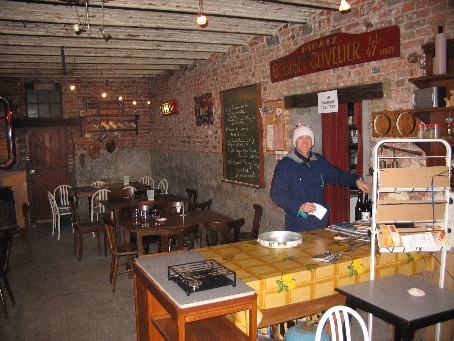 |
He got us a room in town by phoning ahead for us. The place looked like a residence; upon walking by one would have had no idea that it has rooms for rent. We checked in. It was primitive yet nice. The toilet seat was a flat wooden bench, the only one like it I had seen outside of an outhouse.
We went back to the tasting room, bringing in our Westmalle cheese, as well as bread and crackers we had brought from Marty’s house. Jean-Louis brought out his own mixture of 20 spices and hops, which went well with the cheese. Cochonne (9%), made with roasted chicory, coriander, sweet orange peel, and lichens, had a slightly sweet/fruity/spicy aroma and a fairly good fruity, somewhat sweet flavor. Next he treated us to a 30-year-old bottle of Saison, made by the Voisin brewery, which went out of business in 1990. It had a nice somewhat tart aroma and a quite good tart flavor. The corked bottle was very dirty and looked 30 years old. I think it’s the oldest beer I ever drank. Our last Vapeur beer of the evening was Mont-Marche Tournai (7.5%). It had a fairly good fruity, slightly spicy aroma and flavor. He makes it every two years. Jean-Louis has brewed at Vapeur since 1984, and he homebrewed for four years before that. We spent close to four hours there and had a marvelous time.
We went back to our room, taking a couple of our beers in with us. Bière du Corsaire (Huyghe; 9%) had a nice sweet, slightly estery/spicy aroma and a good sweet, slightly fruity flavor with a somewhat alcoholic aftertaste. Triple Moine (Du Bocq; 7.3%) was a yeastless, light-bodied beer with a fairly good fruity, sweet aroma and a fairly good somewhat sweet/fruity flavor.
Thursday the 10th. The dining room at our “hotel” has a big fireplace and a high ceiling. The kitchen, which is in the same room, has a big griddle. We were served breakfast by Guido Servayge, who runs the place with his wife, Carine Callens. (It is the norm in Belgium for married women to keep their maiden names.) He is a large, burly, powerful-looking man who made me wonder why I ever bothered to lift weights because I could never hope to attain his size or strength even if I lived at Gold’s Gym and popped steroids like Bob Dole pops Viagra. Anyway, he’s a carpenter, and he showed us pictures of homes and taverns he has built. He said that many new taverns get bricks that look old in order to create atmosphere. If you’re ever in the Pipaix area, you might want to stay at Chambres d’Hôtes.
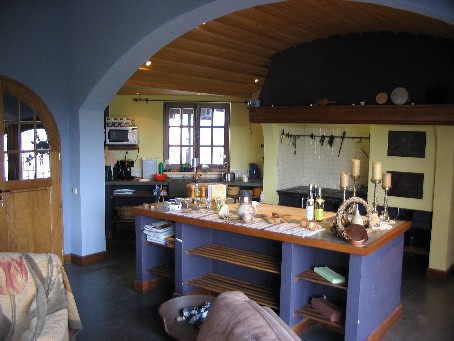 |
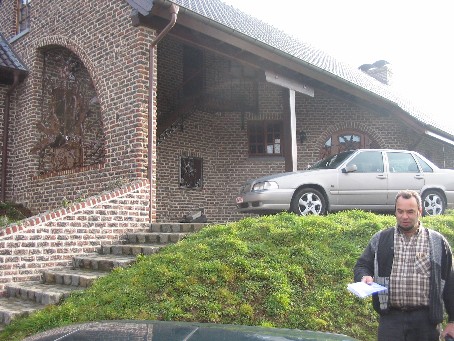 |
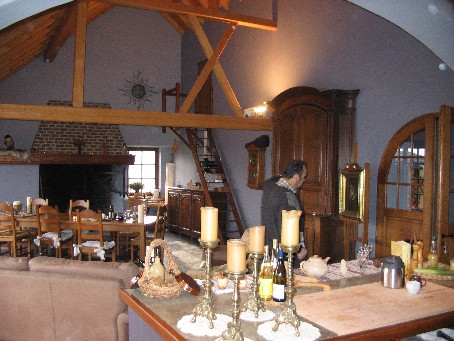 |
Off once again into the Belgian countryside. Within a minute we were in the middle of nowhere, with no houses, just flat land and intersections without signs. We went by Brasserie Dubuisson, purely by accident, so we stopped and I ran in to see if we could get a tour. Impromptu tours are given only on Saturdays; during the week an appointment is needed. I went back to the car, which by now was quite weighed down in back with all the beer.
On another whim we stopped in Ohey looking for Brasserie François. I went into a convenience store to ask for directions. I suppose this is one of the ways in which I’m not a “real man”. A lot of guys absolutely refuse to ask for directions, even if they end up driving to Fiji; whereas in the interest of time, I am the first one to seek help, even from people who don’t speak English. Which is exactly what happened in Ohey. There was a cashier and a customer, neither of who spoke a word of English, but with my very limited French I was able to convey what I was looking for. The customer finished his can of Jupiler and told me to follow him. A few minutes later he led us to a restaurant, which he said Mr. François owns, and a little further he led us to a commercial space that was obviously closed. After he left I went inside, where a construction guy was working. He told me – in French, so I didn’t understand much of it – that it had closed three weeks earlier. Either that or I had a wolverine in my girdle. No, the first one was probably right.
We drove around the corner to Mr. François’s restaurant, the Relais d’Engoran. The décor theme is “Histoire de la Guerre de la Vache” (History of the War of the Cow), with old, dark wooden furniture and ceilings. There is a fake prison cell with a troll in chains. In addition to about 60 beers from various breweries, this place serves several beers that are available only there. These house beers are contract brewed and bottled by Van Steenberge and carry the name Brasserie François on the label. The place around the corner that had closed was just a distribution center, so there never was a Brasserie François per se. Mr. François was very congenial. He showed us a video about the restaurant and the beers, and he served us our beers personally. We got the sampler: three Brasserie François beers in ceramic chalices. La Condruze (7.5%) had a light malty/caramelly aroma and a good smooth, somewhat malty, alcoholic flavor. La Filée (8%) had a nice estery, sweet aroma and flavor. La Triple d’Engoran (9%) had a good fruity, cidery aroma and flavor. The food was wonderful. We bought some of his beer to take with us after lunch. As we left, he gave us a couple of ceramic chalices for free. I highly recommend the Relais d’Engoran, which is open Wed-Sun 11 a.m. to 10 p.m.
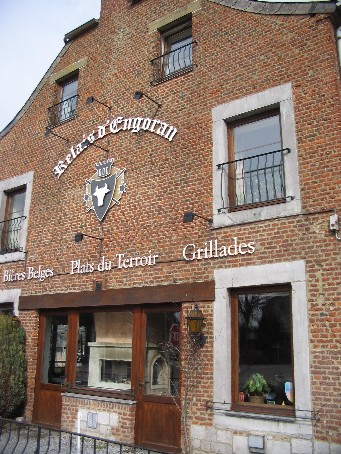 |
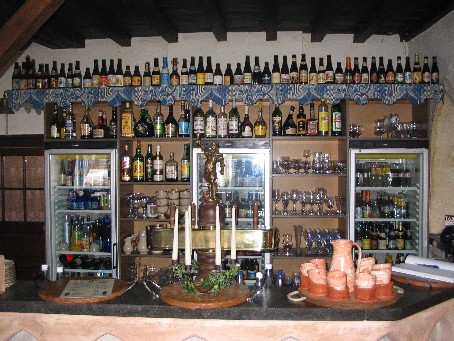 |
Next stop: Durbuy, the tiniest little tourist trap you’ll ever see. We went into a small brewpub that houses the tiny brewery, La Ferme au Chêne. The entire brewing operation exists in a 20-by-20-foot room encased in glass, like a museum exhibit. A video informed us that they do a 3-hour mash schedule that goes from 45-75°C (113-167°F). They add sugar and pelletized hops to the boil. The bottles are capped and labeled by hand. They claim to be the first microbrewery in Wallonia, having started in 1331. The brewery was out of service for an unspecified amount of time, and started up again in 1989. We went into the bar/restaurant and tried the one beer they make: Marckloff (6.5%), on draught. It had very little aroma and a light, slightly fruity, hoppy flavor. A good tame, crossover beer for tourists. Refreshing and drinkable to the bottom of the glass.
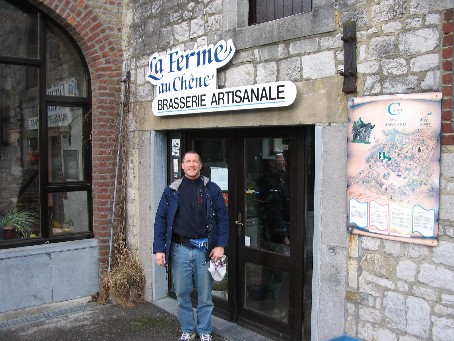 |
The town is very quaint and cozy, with narrow cobblestone streets and stone buildings. But you are constantly reminded of its tourist bent, especially when you see the mini-golf. It looks a bit like Harpers Ferry, only with more stores. We stopped in a store and bought several kinds of beer. We drank one in the car: Chapeau Banana Lambic (De Troch; 3.5%). It had a nice banana-y, tart aroma and flavor. It was more like a wine cooler than a beer.
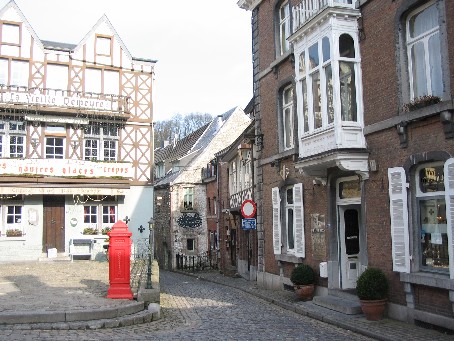 |
We drove to the town of Ambly and found the Saint Monon brewery, our first scheduled stop since the previous afternoon. It’s right next to a farm and it smells like manure. It’s a very small brewery in an old stone building. We were lucky enough to catch the brewer, Pierre Jacob, just as he was leaving. He’s been in business since 1996. Saint Monon Amber (6.5%) had very little aroma, and a light flavor with a slight bit of hops. We bought several beers. I remembered tasting his Saison de Mai the previous year, which I liked a lot, but he didn’t have any at the brewery. However, he told me about a beer store in Bastogne that sold it. The beer gods were with us once more, because we had planned to stay in Bastogne that night.
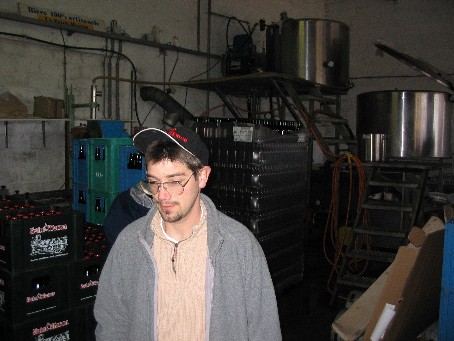 |
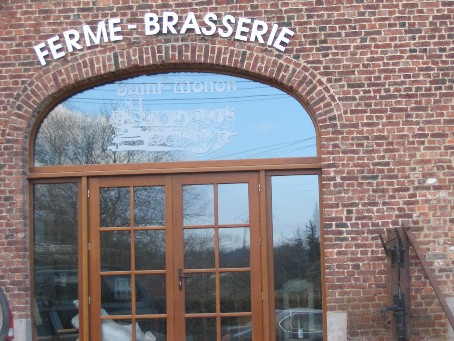 |
We made another unscheduled stop, this time at Abbey Notre-Dame Saint Remy (Rochefort) because it was on our way. They don’t give tours, which didn’t surprise us because none of the other Trappist breweries do. We drove around and Marty took pictures. Now we have been to 5 of the 6 Trappist breweries (all except Achelse Kluis).
 |
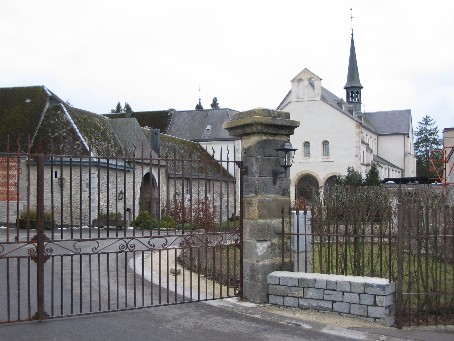 |
Next we drove to Libramont-Chevigny for dinner at ¥.€.$. (Yen. Euro. Dollar.) The atmosphere was sort of average modern. Sara (Silenrieux; 6%), a buckwheat beer, had a good malty, plummy aroma and a pretty good plummy flavor. La Poiluchette Blonde (Huyghe; 7.5%) was served in a ceramic mug that made it foam half an inch above the rim. The beer had so much body that the foam stayed in place like a sundae, and Marty ate it with a spoon. Try that with a typical lager. Anyway, it had a nice estery, sweet aroma and a good estery, sweet flavor with just enough hops and a good aftertaste. Ramée Blonde Tripel (Brunehaut; 8%) had almost no aroma or flavor. Liefmans Jan Van Gent (Liefmans; 5.5%) had a good somewhat fruity, musty aroma and flavor.
The food menu was in French and English. I ordered “American Fillet”, and they brought me a plate of raw hamburger. I shit you not. I learned the hard way that “fillet” is not fish, nor is it even cooked. Apparently word has gotten out that Americans like nothing better than RAW HAMBURGER for dinner, which is how it got the name American Fillet. It was the only restaurant meal I have ever sent back in my entire life. Now, I get as P.O.ed as anyone when someone sends a meal back just because it’s a bit undercooked or overcooked, but when someone hands you a plate of RAW HAMBURGER, as though you’re a feral cat or something, this is what’s called an extenuating circumstance. So I indicated with broken French and facial grimaces that I wasn’t about to eat a freshly slaughtered cow, inasmuch as it was still moving, and that I was certainly a complete weirdo because I was the only American on the planet who did not eat RAW HAMBURGER for dinner, not to mention the world’s biggest idiot because I did not know that American Fillet meant “cold, raw, unprocessed, uncooked, ground up cow flesh”. They were very nice about it though, and graciously cooked me an impromptu chicken dish, even though it wasn’t on the menu. In fact, I didn’t see any chicken on the menu, and I surmised that if there wasn’t chicken on the menu, there wouldn’t be any in the kitchen, and if so, where did this “chicken” come from, and I started looking around for an empty dog collar, but after the raw hamburger incident I figured I shouldn’t be so picky.
We went to Bastogne and checked into the first hotel we found, Hotel de Sud. It was a smoky dive with tiny bedrooms that did not warrant $92 a night, but what can you do? The unfriendly old woman who took our money made us give her a passport so she could write the number down, I suppose in case I had traveled halfway around the globe just to trash a room whose one good quality was that it had running water.
Time to drink. Again. We walked to a bar called Brasserie Lamborelle. Small, cozy, and dimly lit, it had a sort of primitive décor, with an indoor roof and street lamp. A few hanging lamps were lightbulbs inside large beer bottles. Lots of metal beer signs hung on the walls. A tight wooden spiral staircase led down to the bathrooms. The menu listed close to 130 beers. They serve food too. They’re open every day except Monday. Newton Bière à la Pomme (Lefebvre; 3.5%), made with 20% apple juice, had a nice apple aroma and a good semi-apple flavor. La Sarrasine (Bouillon; 6%) was a decent light pale ale with a little tartness.
There were lots of bars within a small radius, like Fells Point but scummier. Some parts of the town actually stank. We went back to our room and had a Steendonk Brabants Witbier (Palm; 4.8%). It had a nice “witty” aroma; the flavor was all right but a bit watery.
Friday the 11th. Our hotel was the only one on our entire trip that did not include breakfast. In the light of day the town looked even more filthy than it had the night before. It’s mostly bars, hotels and restaurants. There were actually fewer cars than there had been the night before, which means that either they were stolen or a lot of people come into town just to drink. The place just has an unfriendly feel to it. There isn’t even a brewery to make it a worthwhile place to visit. The only good thing I can say about Bastogne is that we didn’t get our car broken into.
Half a kilometer from the center of town we found Ardenne Boissons, the beer store that the brewer at Saint Monon had told us about. It’s the 2nd drive-thru store we’ve found. There were only about 50 kinds of beer, mostly from the region, but there were several that we had not found anywhere else, including Saint Monon’s Saison de Mai.
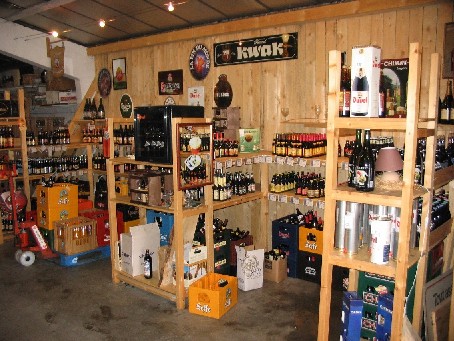 |
We bought a bunch of beer and drove to...
Brewer Gregory Verhelst gave us a warm greeting. This was our 3rd visit to his place. He brought us into his office and let us try a new beer (~9%) that he had made with the same yeast strains that Orval is made with. He hadn’t given it a name. It had a very good horsey, alcoholic aroma and flavor. It was sweeter and less hoppy than Orval. The recipe is the same as his Triple; the addition of the Orval strains is the only difference. Then we drank my homebrewed attempt at cloning his Triple. I had attempted another clone a year earlier, but my gravity had been too high. Gregory subsequently told me his Triple’s gravity, so I tried again at this gravity, and this time the beer turned out much closer to what I was shooting for. It wasn’t an exact duplicate, nor was it as good as his Triple, but he did find it “very drinkable”. He said that because I don’t have access to the same malt and water he uses, it would be very difficult to clone his beers.
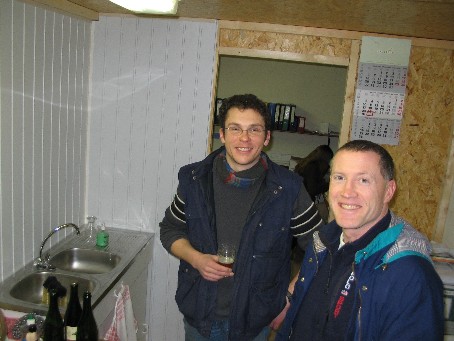 |
Eventually his assistant Olivier showed up. Marty and I hung out with them in the brewery for a while as they brewed. They use fire heat, as do Dupont and Ellezelloise and a number of others. We went into the tasting house, and the bottles I had given them the previous year were still on the mantle. We bought some beer and glasses and said good-bye. We always enjoy visiting them. Our Belgian beer travels are not just about the beer – the great people we meet make our journeys splendid.
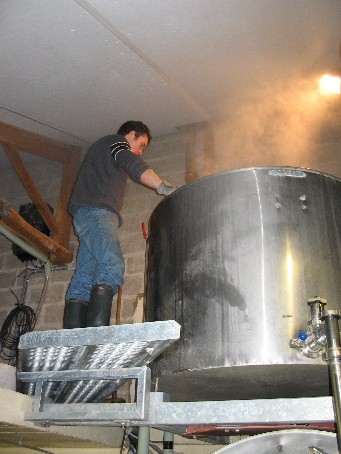 |
 |
We had lunch at Buffet de la Gare in nearby Marbehan. It’s quite a fine establishment when you consider that it’s located at a train station. It had a good ambience and nice leather-bound menus. Rulles Triple (Artinasale de Rulles; 8.4%) had a nice malty, alcoholic, somewhat estery aroma and a nice estery, malty, alcoholic, earthy flavor. Certainly better than my “clone”. The food was quite good. After eating we talked with the bartender, Jean-Claude Carisse (not sure of the spelling), who told us of a new brewery called Millevertus that had been open for about a year. He gave us samples of two draught beers. Rulles Blond (Artinasale de Rulles; 7%), which we had had in bottle several times before, had a good estery aroma and a pretty good estery flavor. A good light beer. Diekirch (Diekirch; 5.2%), from Luxembourg, was a typical light, flavorless pils. We bought a bottle of something (I can’t remember what) to take with us, and he gave us two more bottles of other stuff.
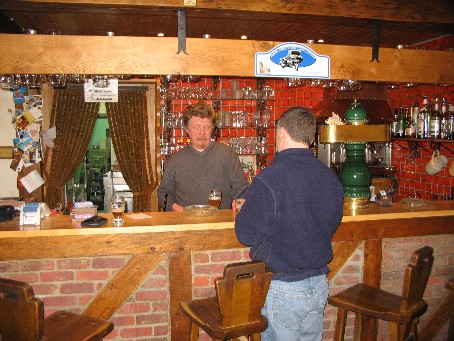 |
Next we landed in Suxy to drink at a bar called Au Stop. Around the side of the bar, inside the building, is an old bowling alley, no longer in use, that starts out only a foot wide, then about halfway down gets wider. The bar has been in operation since 1992. As people came in, everyone greeted everyone: men shook men’s hands; men and women kissed each other on the cheek. La Gaumaise (the label said “Créée par Brasserie Maire Meix Devant Virton”; 5%) had a light slightly fruity aroma and flavor. It wasn’t very good. Abbaye de Bonne-Espérante (Lefebvre; 7.8%) had a good sweet, malty aroma and flavor. Trappistes Rochefort 10 (Abbey Notre-Dame Saint Remy; 11.3%) had a good malty, caramelly, slightly fruity aroma and a pretty good caramelly, alcoholic flavor.
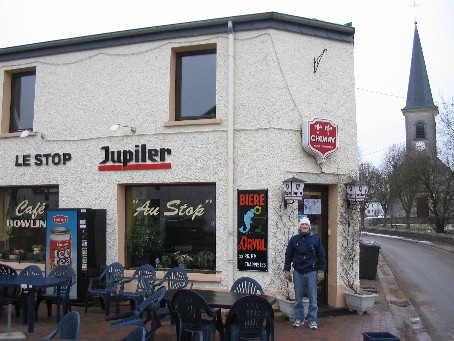 |
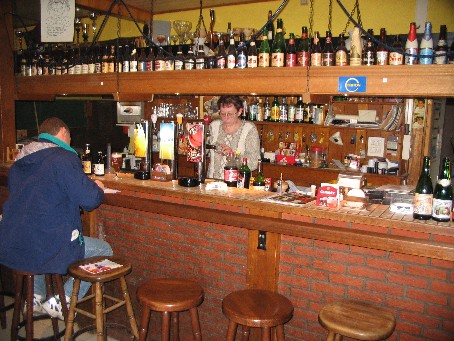 |
We have spent more time in Bouillon than in any other Belgian town. This was my 3rd time there and Marty’s 4th. It’s a pretty little place tucked in a mountain valley with a river running through it and an old castle on a hill overlooking the town. We checked into Hotel de la Poste and immediately went drinking at La Vieille Ardenne. Maredsous 10 (Moortgat; 10%) had a nice alcoholic, fruity, cidery aroma and a good alcoholic, fruity, cidery flavor. St. Louis Gueuze (Van Honsebrouck; 4.5%) had a good moderately tart aroma and a good somewhat tart, fruity, cidery flavor. It had no yeast and was too sweet to be a real gueuze. Leffe Blonde (Leffe; 6.6%) had a pretty good slightly estery aroma and a good estery, spicy, sweet flavor. I had to step outside the bar to enjoy it because it was so smoky in there.
We went back to the hotel and got two of our old favorites out of the car (the weather was still cold and cloudy so the beer was kept at great drinking temperature). We drank them in one of our rooms (we had rented a triple and a quad because five more people would be joining us that night). Dulle Teve (De Dolle; 10%) had a nice estery, sweet aroma and a nice malty, estery, spicy, sweet, alcoholic flavor. Delirium Tremens (Huyghe; 8.5%) had a nice estery, spicy, fruity, sweet aroma and a nice spicy, estery, fruity, sweet flavor. Then we went to the hotel bar. Diekirch Grand Cru (Diekirch; 5.1%), from Luxembourg, had a caramelly aroma and flavor that were one-dimensional and adequate at best. Belle-Vue Gueuze (Interbrew; 5.5%) had a good fruity aroma and a good fruity flavor with just a hint of mustiness. It had no yeast and was not a real gueuze. The bar, like the lobby, is pretty and looks like something out of the first half of the 20th century. Old furniture in the bar and Oriental-looking rugs in the lobby give it a nice ambience. The bar also has an Internet terminal next to an old telephone switchboard. The computer’s keyboard is a bit different from the kind Americans are used to: some letters are in different places, and the digits and special characters are reversed (i.e. you have to hit SHIFT for digits but not for ampersand, percent, etc). Marty got his E-mail and I wrote until Michelle, her brother Bill, her cousins Ann and Russ, and our friend Steve showed up.
All of us went out to dinner. Everyone except me got beer because I had had enough for the time being. I did taste one though. Grimbergen Blond (Alken-Maes; 6.7%) had a good sweet, estery aroma and flavor. Then we went back to one of our hotel rooms and drank beers from the car. Louwage’s Kriek (Alken-Maes; 4.3%) had a nice strong cherry aroma and a pretty good cherry flavor that disappeared quickly. Gouyasse Tripel (Des Geants; 9%) had a pretty good alcoholic aroma and a pretty good alcoholic, dry flavor with a somewhat bitter aftertaste. Loteling Blond (Huyghe; 8.5%) had a good sweet, fruity aroma and a good somewhat sweet, fruity flavor. Saison Voisin (Des Geants; 5%) had a fairly good slightly fruity aroma and an unpleasant dry flavor. We ended with a dessert beer: Chapeau Fraises (De Troch; 3.5%) had a good strawberry aroma and a good tart, strawberry flavor.
Saturday the 12th. We had a very nice breakfast at the hotel, then went to Marché de Nathalie to buy beer. Tucked in the back of this shop is Brasserie de Bouillon. We had met brewer Jacques Poogin and his wife Nathalie (after who the store is named) before. On this day they had their two young children with them, the younger of who was only a few weeks old.
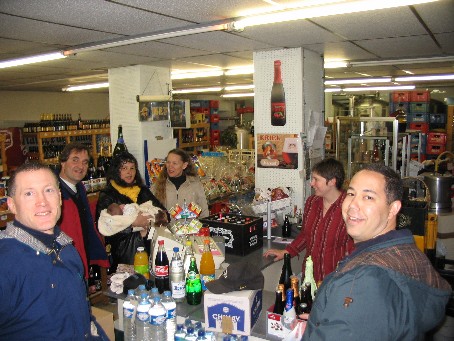 |
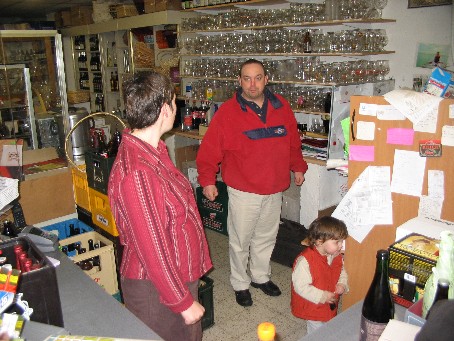 |
While we were in there it snowed hard, then cleared up. We then bought chocolate at a few shops and drove to...
We had seen signs for a chocolate festival in this town as we drove to Bouillon the day before, so naturally we had to go. We all love Belgian chocolate, and Anne is a chocoholic. We got to taste and buy chocolate from several vendors. There was also a chocolate art contest, and people made chocolate pictures, furniture and clothing.
The Orval abbey was originally built in 1070, but it was destroyed during the French Revolution and subsequently rebuilt in the late 1920s. Outside were black sheep and white pigeons. In addition to supervising the production of beer, the monks make two kinds of cheese: “new” and “old”. I had had them before, and they’re great, so I bought upwards of 20 pounds of them. They used to make bread until sometime in the 1990s, but they stopped because they no longer have the manpower (the monks are aging and dying, and there aren’t enough young men becoming monks to replace them). We bought 48 bottles of their beer, which worked out to less than $1.50 a bottle; in the States a single 12-ounce bottle will run $5-$6.
We walked around the grounds and saw the old ruins. It was quite pretty and interesting. It snowed and hailed on us, then cleared up. There is a cave (arched tunnel) that leads to a museum that displays the abbey’s architecture at different times in history, fossils, old pottery pieces, and other artifacts. Stalactites hang from above.
Just down the road is a café called Auberge de L’Ange Gardien that is associated with Orval. We got three bottles each of the regular Orval (6.2%) and the Petit Orval (3.5%), the latter of which the monks drink and is available to the public only at this café. The lighter version had a fairly good slightly horsey aroma; the flavor was light, dry, and somewhat bitter. I didn’t like it, but Michelle and Steve preferred it. Different strokes. The regular Orval beer, by comparison, had a nice horsey aroma and a good horsey, somewhat alcoholic flavor with ample bitterness. We hadn’t eaten in almost six hours so we got drunk on one beer each. We also ate there. The food was quite good. They serve Orval’s “new” cheese, but not the “old” cheese for some reason; however, there is an omelette made with the “old” cheese. While we were there, a blizzard hit for a while, then cleared up. The weather in this region moves faster than beer through my bladder.
We drove back to Bouillon. From our stash we drank The Same Again (Bosteels; 6.1%). It had a fairly good caramelly aroma and a barely drinkable, somewhat caramelly but dry, stale flavor. Then we walked up to the old castle, called the Chateau-Fort. It was getting near closing time but we were able to walk around inside for a while. It’s all stone, dark and dank. There were vultures and a falcon chained by the leg. I think falconry demonstrations are done there (falconry was big at the time the castle was in use).
We descended into town again and drank at Café du Centre. It was a very smoky bar, so we sat by the door and I opened it every time I sampled beer, much to our server’s displeasure, but I wasn’t going to let that ruin my enjoyment. Besides, the profit that the bar made from us more than paid for the few heat units I caused to escape. Bush Nöel (Dubuisson; 12%) had a good malty, alcoholic aroma and a nice sweet, malty, alcoholic, spicy flavor. Stella Artois (Interbrew; 5.2%) – the Budweiser of Belgium – was devoid of aroma and flavor, but it was served with lemon soda. This concoction, called Panaché, tasted kind of sweet, like ginger ale. Regal Christmas (Du Bocq; 8.1%) had a good malty, caramelly aroma and a good malty, slightly roasty flavor. Gordon Highland Scotch Ale (John Martin; 8.6%) had a slightly caramelly aroma and a good malty flavor with noticeable bitterness. Chimay 2004 Grande Reserve (Abbey de Notre-Dame de Scourmont; 9%) had a good malty, slightly alcoholic aroma and a pretty good malty, alcoholic, somewhat bitter flavor. Their beer menu had many more selections than were advertised in their window – more than 50. At one point I asked our server, in French, for the beer menu, and she brought me a bunch of beer coasters. That was one of the best misunderstandings I’ve ever experienced.
The evening was spent in our hotel room playing cards and lightening the car’s load. The beers kept nice and cold by the open window. Cuvée Ermesinde (Saint Monon; 8%) had a fairly good somewhat malty/fruity aroma and a fairly good malty, slightly alcoholic flavor with a somewhat dry aftertaste. Fruitesse Framboise (Liefmans; 3.5%) had a nice raspberry aroma and flavor. It was sweet but not too sweet, with nice tartness, like a soda but better. Guldenberg (De Ranke; 8.5%) had a good light, fruity, slightly malty aroma and a decent fruity, hoppy flavor. St. Idesbald Blond (Huyghe; 6.5%) had a good fruity aroma and a good fruity, tart, alcoholic flavor with robust carbonation. Hercule Stout (Ellezelloise; 8.4%) had a pretty good roasty, sweet aroma and a fairly good phenolic, slightly roasty flavor. Delirium Nocturnum (Huyghe; 9%) had a good malty, slightly alcoholic aroma and a fairly good sweet, somewhat estery, slightly roasty flavor. Grottenbier Brune (Sint Bernardus; 6.5%) had a good fruity aroma and an unpleasant, somewhat fruity/dry flavor. Some of us liked it. Bink Blond (Kerkom; 5.5%) had a good fruity aroma and a decent light, slightly fruity/hoppy flavor with light body. We ate Dupont and Westmalle cheese, crackers, and gyro-like sandwiches called döners. Vanille (Vapeur; 5%) had a fairly good somewhat fruity, alcoholic aroma and a pretty good tart, musty flavor, somewhat like a gueuze. Mousse de Toernich (Millevertus; 5.5%) had a fairly good fruity, slightly spicy aroma and a decent spicy, hard-to-describe flavor. Kastaar (Apfüllung; 6%) had a good cidery, fruity, spicy aroma and a fairly good spicy, slightly tart flavor. La Maarteloise (Bouillon; 6%) had a pretty good somewhat fruity, slightly hoppy aroma and a fairly good hoppy, spicy flavor. Delirium Tremens (Huyghe; 8.5%) had a good fruity, somewhat alcoholic, estery aroma and a nice estery, sweet flavor. Lindemans Kriek (Lindemans; 3.5%) had a great cherry aroma and a nice cherry, tart flavor. Belzebuth (Grain d’Orge; 13%) had a pretty good malty, alcoholic, but somewhat stale aroma and an okay malty, alcoholic, stale flavor with an unpleasant aftertaste. Gordon Xmas (John Martin; 8%) had a decent malty, caramelly, alcoholic aroma and an okay malty, sweet, caramelly flavor. La Petasse (Bouillon; 6%) was very similar to La Maarteloise, adding to my suspicion that many of the Bouillon beers are actually the same beer. Toernichoise (Millevertus; 6.5%) had a fairly good fruity aroma and a decent somewhat malty, bitter flavor. Quintine Blonde (Ellezelloise; 8%) had a good fruity, estery, spicy aroma and an okay spicy, somewhat estery flavor. It was a lot of fun drinking together. Remember, there is no ‘I’ in drunk.
Sunday the 13th. The hotel provided us with another good breakfast. We transferred much of the beer from Marty’s car to the rented minivan, and packed both vehicles tightly with our personal stuff and purchases. Then we all headed down to France to have a French meal somewhere.
The beer gods smiled upon us yet again: we stumbled upon the Musée Européen de la Bière (European Beer Museum) in Stenay, France. Not only that, it’s normally open only April 1 to October 31, but they were having some sort of special event, so it was open even though it was March. It’s in an old dusty building. It shows the history of beer from Mesopotamia to Egypt to Europe and Asia, beer bottles from different countries, the brewing process, regions in Europe where different maltsters are, regions in the world where hops are grown, old pictures, and old brewing equipment (mash kettles, chillers, yeast culturing apparatus). A map of French breweries showed that most are concentrated near Belgium. Even in 1890, 1597 of the 2485 French breweries (64%) were located along the Belgian border. Saint Arnould is the patron saint of brewers. There were pictures of the inside of several breweries, including Orval. There was a bar with many European beers for sale. A local brewer was offering free tastings of his Bière du Mars (Brasserie de Charmois; 5.9%). It had little aroma and a pretty good somewhat sweet flavor. He studied brewing at Orval.
On a tip we went to Thonnelle looking to have lunch at La Bonne Auberge. We found it, but they were quite crowded and told us we’d get faster service if we returned in 45 minutes. So we took a side trip to Citadelle de Montmédy, a walled town. At first it looked like a ghost town because so much of it was abandoned or run-down, but upon walking around we saw that many of the rowhouses were inhabited. There’d be a rowhouse that was basically in ruins, and then one that was painted and curtained. It was hard to believe they were connected. Kids were riding bikes and a few people were returning home while we stupid tourists gawked.
The cold weather shortened our visit as we retreated to our vehicles for warmth. Well, I did, anyway, which shows what a wimp I am. Eventually everyone in our posse returned and we drove to Thonnelle.
La Bonne Auberge seemed to be the only thing open in this tiny town. It must be the local hub because it was still crowded in the middle of the afternoon, which is neither lunch nor dinner time. Everyone was drinking wine. It’s interesting that as soon as you cross the border from Belgium into France, the balance shifts from mostly beer drinkers to mostly wine drinkers. The wine list was very long, while the beer selection was somewhat limited. Ciney Blond (Alken-Maes; 7%) had a good somewhat sweet aroma and a pretty good somewhat fruity flavor. Belle-Vue Gueuze (Interbrew; 5.2%) had a good tart, musty, sweet aroma and a nice tart, fruity flavor. The food was wonderful.
We drove back to Stuttgart along beautiful countryside and farmland. Michelle took Steve in the car and dropped him at a train station along the way because he was going to Italy for a ski trip. The other five of us went in the van, the back of which was so weighed down with beer that the headlights aimed slightly upward and people coming the other way were flashing their headlights at us because they thought we had our high beams on. Somehow Michelle beat us to her house. The six of us unloaded the vehicles and went to sleep WITHOUT DRINKING BEER, which shows how tired we were.
Monday the 14th. Michelle went to work, thus being the only productive citizen among us that day. Marty and Bill worked out and did other stuff. Anne, Russ and I drove to a ski area with the intention of doing some cross-country skiing. It was an adventure as we got lost, found a beautiful snow-surrounded hotel in the mountains, watched a guy para-ski, and endured the strong, cold winds. We found a ski rental place and rented equipment. The elderly gentleman working there didn’t speak a single word of English and we didn’t speak any German, but I managed to communicate with him via the dignified method of using frantic hand gestures. We drove back up to the hotel, which was surrounded by plenty of flat, snow-blanketed land. Unfortunately Anne had been given skis and ski boots that would not connect to each other, and being a bit tired and cold she opted to rest in the car while Russ and I skied. This was the second time I had ever skied in my life, so I was unsteady at first, but I soon got into the groove. Literally – there were grooved ski trails for much of our route. I fell only about 10 times, which isn’t bad compared to the first time I skied, when I fell about a jillion times. The gorgeous mountains and pristine air were very uplifting (but not enough to keep me from falling). It was the only exercise I had gotten since that day at the gym a week and a half earlier. Unless you count the 12-ounce curls I did all through Belgium.
We returned to Marty and Michelle’s house and had dinner. Marty and Bill had arranged a large table with 225 different Belgian beers. I can’t imagine that such a collection existed anywhere else in Germany, especially since it is very difficult to find any beer for sale in that country that isn’t German.
My palate was not in a beer mood, probably because I was tired and relaxed from skiing, so the beers we had were probably better than my notes would indicate. Tripel Karmeliet (Bosteels; 8%) had a good sweet, estery aroma and flavor. Bornem Double (Van Steenberge; 8%) had a pretty good malty, slightly caramelly aroma and a fairly good slightly malty, slightly tart flavor. Saison de Mai (Saint Monon; 8.3%) had a good malty, somewhat alcoholic aroma and a good malty, nutty, slightly alcoholic flavor with a tiny bit of hops in the finish. Zottegemse Grand Cru (Crombe; 8.4%) had a quite good tart, horsey, slightly sweet aroma and flavor. It was similar to Orval but not as hoppy. La Filée (Van Steenberge; 8%) had a nice malty, estery aroma and a good estery, somewhat sweet flavor with fairly light body. Egmont Zottegemse Tripel (Crombe; 7%) had a good fruity, slightly estery aroma and a good smooth, somewhat fruity, slightly estery/tart flavor. Souvenirs du Terroir (De Landtsheer; 9%) had a nice fruity, somewhat estery aroma and a nice fruity/estery/alcoholic flavor.
The Ides of March brought a taste of spring. The weather cooperated nicely throughout our trip: it was cold when we had beer, chocolate and cheese in our vehicles and when we skied; and it warmed up when we did other outdoor stuff. Marty, Bill, Anne, Russ and I drove to Ritter Sport (a German chocolate outlet) and bought chocolate. We went to a folk museum in Waldenbuch. It had artifacts from the region: farming and blacksmithing equipment, clothing, pottery, textiles, paintings, firearms, kitchen equipment, furniture and an old loom. The museum is in an old palace.
Next we drove to Nagold and walked up a large hill to Hohennagold, which is old castle ruins (there are lots of castle ruins throughout Europe). I brought a backpack with beer. Upon reaching the castle I stuck the bottles in the snow to keep them cold. We sat at a very thick, sturdy picnic table and drank while enjoying the great weather and crisp, clean, fresh air. Lamoral Tripel (Van Den Bossche; 8%) was a smooth beer with a nice sweet, estery aroma and flavor. Abbaye d’Aulne Triple Brune (Val De Sambre; 9%) had a good fruity, raisiny, malty aroma and a good raisiny flavor with a somewhat tart aftertaste. Barbãr (Lefebvre; 8%) had a nice sweet, estery aroma and flavor. Lindemans Gueuze (Lindemans; 4.5%) had a nice quite tart, somewhat musty aroma and flavor. Saison de Mai (Saint Monon; 8.3%) had a quite good nutty, somewhat sweet, unique aroma and a quite good nutty, somewhat woody, sweet, unique flavor. Bush Blonde (Dubuisson; 10.5%) didn’t have much flavor or aroma, but was a good, smooth, alcoholic beer. Mort Subite Framboise Lambic (Mort Subite; 4.5%) had a great raspberry aroma and a quite good raspberry, tart flavor.
The walk down was easier, especially for me since the bottles were empty. We negotiated snow, ice and mud, and I think only one person fell. Maybe I shouldn’t have pushed her.
We returned to Marty and Michelle’s and had a Gulden Draak (Van Steenberge; 10.5%). It was a smooth beer with a pretty good fruity, alcoholic, raisiny aroma and a pretty good alcoholic, fruity, raisiny, sweet flavor.
Bill and I went with Marty and Michelle to the home of their friends Charlie and Kris, who are also Belgian beer fanatics. In fact, Charlie always has several Belgian beers on hand, so we drank from his collection. St. Feuillien Triple (Friart; 8.5%) had a nice fruity, somewhat sweet, alcoholic, cidery aroma and a pretty good smooth, light, somewhat alcoholic, slightly cidery/fruity flavor with fairly light body. Brigand (Van Honsebrouck; 9%) had a good fruity, alcoholic aroma and a pretty good alcoholic flavor. Grimbergen Dubbel (Alken-Maes; 6.5%) had a good strong, malty, fruity aroma and a good somewhat malty, smooth flavor. Then we had a 1.5-liter bottle of Dragonne (8.5%). It had a good fruity, alcoholic, estery, tart aroma and a pretty good fruity, tart flavor. Durboyse Triple (the label said “S.C. Pronolux B 6941 Tohogne”; 8%) had a nice malty, sweet, alcoholic aroma and a pretty good somewhat malty, estery, fruity flavor. Grimbergen Cuvée de l’Ermitage (Alken-Maes; 7.5%) had a good malty, fruity, somewhat alcoholic, slightly caramelly aroma and a fairly good somewhat fruity, tart, slightly caramelly flavor.
After dinner we came home and did one of the following:
Which one do you think we did? Right. Belle-Vue Kriek (Interbrew; 5.1%) had a good fruity, sweet aroma and a decent fruity, dry flavor. Belle-Vue Kriek Extra (Interbrew; 4.3%) had a nice fruity, sweet aroma and a good fruity, sweet flavor, like a soda. It was definitely better than the previous beer. Achel (Achelse Kluis; 8%) had a good fruity aroma and a good smooth, fruity flavor with a hint of hops. It was well balanced. Queue de Charrue Ploegsteert Blonde (Van Steenberge; 9%) had a good fruity, slightly estery aroma and a fairly good tart, slightly sweet flavor with light body. We finished with a year-old 750-ml bottle of Delirium Tremens (Huyghe; 9%). It had a good fruity, slightly estery aroma and a pretty good fruity, slightly tart flavor. It wasn’t as good as the smaller bottles of this beer.
Wednesday the 16th. I once again showed my lack of manliness by writing, packing and resting while the other guys worked out at the gym. At one point I took a walk so as not to be a complete couch potato. Later on we watched part of Michael Jackson’s Beerhunter. No, not the singer. Michael Jackson is a famous beer writer from Britain.
That night some folks came over to drink Belgian beer and homebrew with us. Hercule Stout (Ellezelloise; 8.4%) was a smooth beer with a good somewhat sweet, roasty aroma and flavor. St. Bernardus Prior 8 (Sint Bernard; 8%) had a good malty, sweet, caramelly aroma and a good malty, alcoholic, slightly caramelly flavor. My homebrewed saison was tasty, refreshing and quite popular. Abbaye des Rocs (Abbaye des Rocs; 9%) had a pretty good caramelly aroma and flavor. Brugse Straffe Hendrik (De Halve Maan; 6%) was an aromaless, flavorless lager. Nostradamus (Caracole; 9.5%) had a pretty good fruity, somewhat malty aroma and a good malty, fruity, slightly alcoholic flavor. Chimay Triple (Abbey de Notre-Dame de Scourmont; 8%) had a nice estery, hoppy aroma and a nice hoppy, slightly estery/alcoholic flavor. Durboyse Triple (S.C. Pronolux; 8%) had a good estery, slightly fruity aroma and a nice estery, fruity, alcoholic flavor with a hint of dryness. Grimbergen Triple (Alken-Maes; 9%) had a good fruity, estery aroma and flavor. Duchesse de Bourgogne (Verhaeghe; 6.2%) had a nice winy, horsey aroma and a good winy, sweet, horsey flavor. My homebrewed hefeweizen had little flavor by comparison, but Michelle enjoyed it. Oud Zottegems Bier (Crombe; 6.5%) had a good slightly fruity, hoppy aroma and a decent, somewhat fruity/tart flavor. Achel (Achelse Kluis; 8%) had a good fruity, slightly estery aroma and a pretty good fruity flavor with a somewhat dry aftertaste. La Guillotine (Huyghe; 9%) had a good fruity aroma and a nice alcoholic, fruity flavor with fairly light body. Bon Secours Blonde (Caulier; 8%) had a nice fruity, estery aroma and a nice estery, alcoholic flavor with slight bitterness. St. Bernardus Abt 12 (Sint Bernard; 10%) had a pretty good malty, slightly alcoholic, caramelly, fruity aroma and a pretty good malty, alcoholic, fruity flavor. There was a hint of hops in the finish; it could use a bit more. Trappistes Rochefort 8 (Abbey Notre-Dame Saint Remy; 9.2%) had a decent somewhat caramelly/roasty aroma and flavor. Bornem Trippel (Van Steenberge; 9%) had a pretty good estery, somewhat alcoholic aroma and a pretty good fruity, alcoholic, slightly estery flavor with light body. Bush (Dubuisson; 12%) had a good malty, alcoholic aroma and flavor but was not at all complex. Duvel (Moortgat; 8.5%) had a nice estery aroma and flavor with quite light body. Bruegel Amber Ale (Van Steenberge; 5.2%) had a fairly good malty, caramelly aroma and a decent somewhat caramelly flavor with a slightly dry aftertaste. Cantillon Kriek 100% Lambic (Cantillon; 5%) had a good tart, fruity aroma and a fairly good sour, tart, somewhat musty flavor; most people didn’t like it. Chapeau Framboise Lambic (De Troch; 3.5%) had a nice fruity, sweet aroma and a nice fruity, sweet, tart flavor. Bière du Corsaire (Huyghe; 9%) had a pretty good somewhat lemony aroma and a good lemony, alcoholic flavor with a slightly bitter finish. Witkap Pater Stimulo (Slaghmuylder; 6%) was aromaless and flavorless. Zinnebir (Sint-Pieters; 6%) had a fairly good somewhat caramelly aroma and a decent hoppy, slightly malty flavor. Mongozo Banana (Van Steenberge; 4.8%) had a nice banana-y aroma and flavor. Caves (no info on the label) had a pretty good sweet, caramelly aroma and a pretty good tart, somewhat fruity flavor. Rodenbach Grand Cru (Rodenbach; 6%) had a good sweet, fruity, musty aroma and a good quite tart, sour flavor. Cuvée de la Jonquille (Saint Monon; 6.5%) had a pretty good floral, spicy aroma and pretty good hoppy, somewhat dry flavor. Judas (Alken-Maes; 8.5%) had a good estery aroma and flavor with fairly light body. Pater Lieven Blond (Van Den Bossche; 6.5%) had a fairly good fruity, slightly hoppy aroma and flavor. La Gatte d’Or (Saint Monon; 7.5%) had a pretty good somewhat chocolaty, hoppy aroma and a decent somewhat malty, hoppy flavor. Ramée Amber (Brunehaut; 7.5%) had a fairly good slightly caramelly/roasty aroma and flavor. Cuvée Li Crochon (6.8%) had a good fruity, slightly hoppy aroma and a fairly good fruity, slightly hoppy/tart flavor. Bon Secours Ambrée (Caulier; 8%), from the previous year, had a fairly good winy aroma and a fairly good winy, cidery flavor with strong carbonation.
Thus ended a 13-day whirlwind beer excursion in which we sampled 203 different beers: 188 Belgians, 9 homebrews, 2 from Luxembourg, and 1 each from Germany, Austria, Italy and France. This brought the number of Belgian beers that Marty and I have sampled in our lives to more than 300. It was our best beer excursion yet. We had good luck, cooperative weather, lots of tasty beer, and great friends to share it. Let other folks take their vacations on some tropical island, getting sunburned and drinking Corona. I’ll take beerhunting in Belgium anytime.
March 17th. Bill and I had to fly home this morning. How ironic that the one day of our trip we didn’t drink was St. Patrick’s Day. Marty and Russ dropped us off at the airport. Our itinerary said to go to Terminal 1. I was carrying 130 pounds of beer, cheese, chocolate and clothing as I followed Bill through the crowd. He went all the way to Terminal 3, where I lost him. I returned to Terminal 1 and went to the information desk where I was informed that our flight would leave from Terminal 3. So I trudged back to Terminal 3, huffing and puffing and sweating as I completed a 47-mile circuit while carrying enough fat, sugar and alcohol to feed the entire airport for a week. No wonder my back still hurts – I overschlepped.
One thing about the Germans: they’re thorough. We went through X-raying and wanding twice. At one point a woman asked me if there was anything in my bag that could be used as a weapon. For a split second I thought about suggesting that perhaps I could strangle someone with my dental floss, but I didn’t put forth that particular idea because I didn’t feel like ending my trip in the pokey with an amorous cell mate named Gunter.
There were two gates for our flight: one smoking and one nonsmoking. I hoped that this was an indication that Europe was gradually moving toward a smoke-free environment.
I learned some valuable information on the trip home:
In case you’re interested (or at least awake by this point), here is a list of my favorite Belgian beers (so far). It’s broken down into three categories: “normal”, fruity, and sour. The beers are listed roughly in order, though not exactly because different moods make me prefer different beers.
“Normal” beers
Fruity beers
Sour beers